-
Posts
1,397 -
Joined
-
Last visited
Content Type
Profiles
Forums
Gallery
Events
Posts posted by archjofo
-
-
Hello,
many thanks to you for your interest and your contributions, as well as thanks to the many LIKES.
Continued: Clarifying the yard arms
After researching contemporary ship models from the Musée national de Marine, I assembled a collection of yard arms as shown below: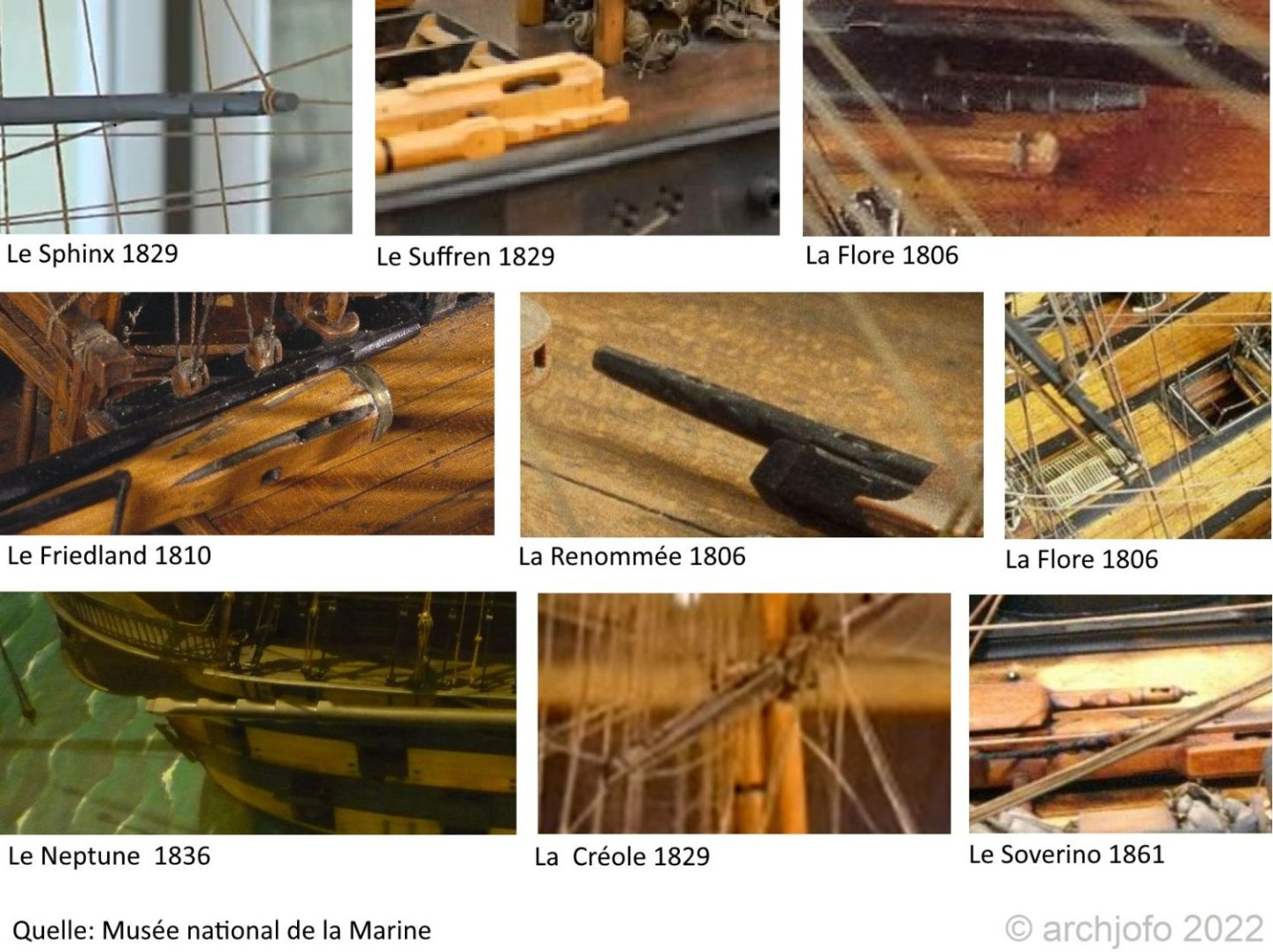
As you can see, there were the most diverse forms of yardarms, probably also depending on the shipyard in which these yards were manufactured. But they all have the "spiky" cleats, which do not always stick out vertically, but often horizontally and are mainly to be found on the topsail yards. The yard arms of the lower yards were somewhat simpler and often designed like the following example from L'Achille 1804: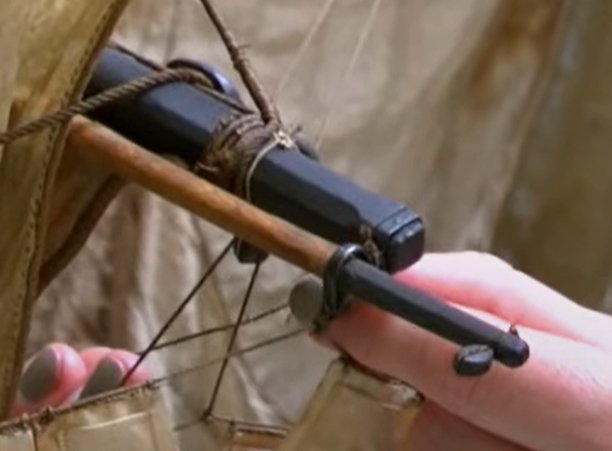
Source: Musée national de Marine, L'Achille 1804
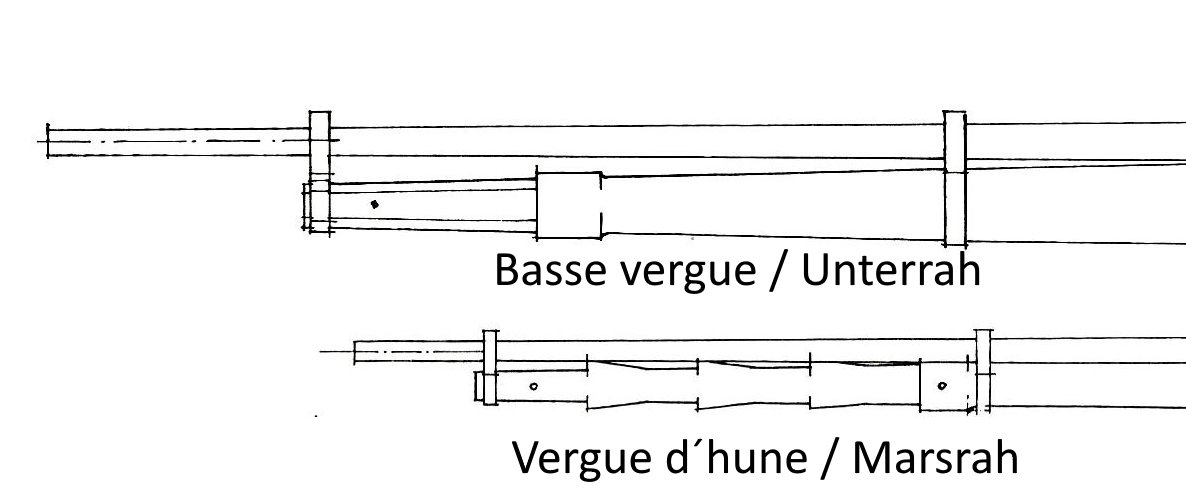
Source: monograph La Créole v. J BoudriotTaking into account the results of the research in connection with Boudriot's drawings, I tried, initially in drawing, to represent the yards of the Mars yards of La Créole as they might have looked. In particular, I orientated myself on the yard arm of the yard on the model of the Le Suffren 1829. Not only does the period fit, the Le Suffren was also designed by the naval architect P. M. Leroux, like the La Créole. Therefore, I see my subsequent attempt at reconstruction as a thoroughly realistic variant.
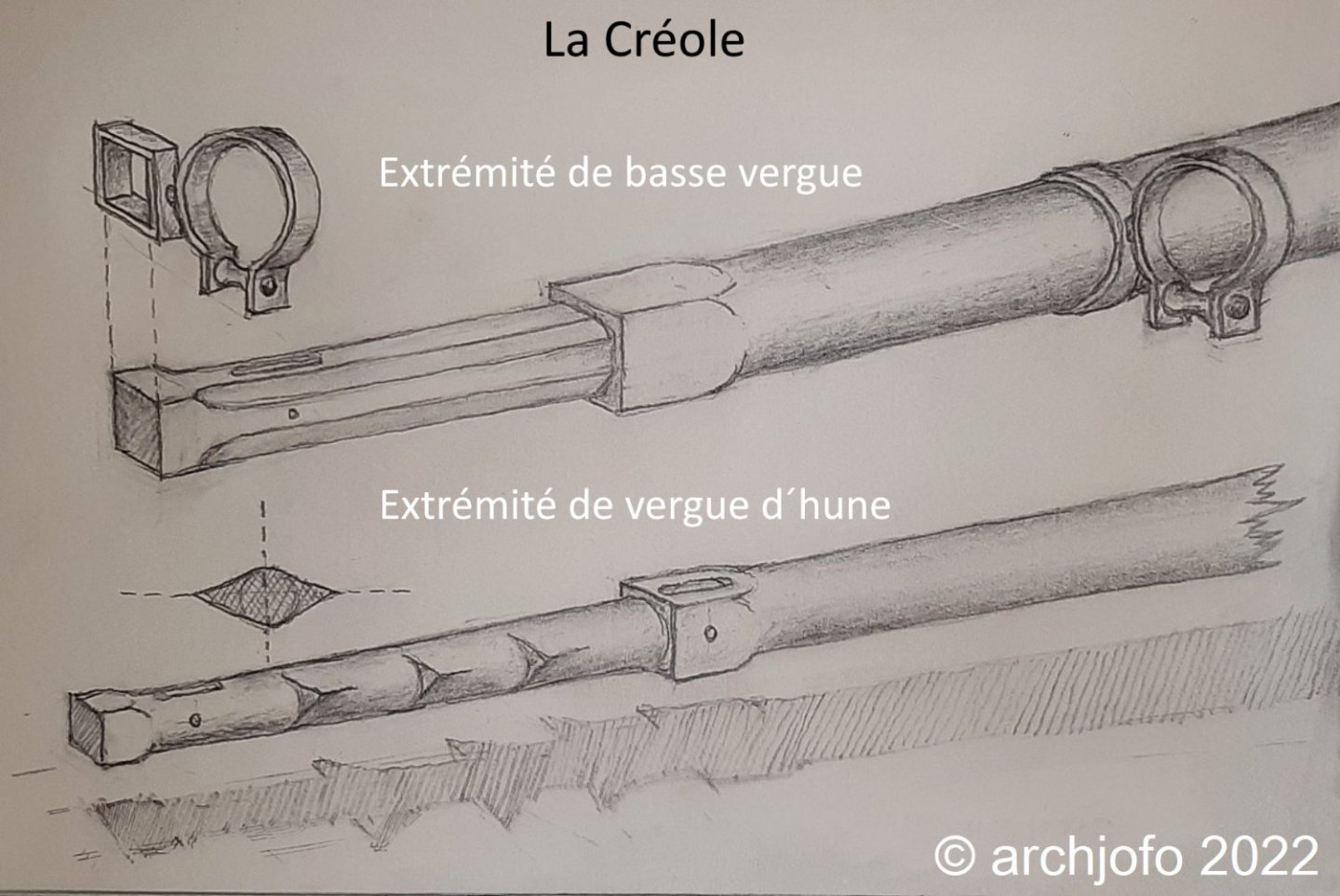
The cleats may also have been vertical. In this respect, I will also draw a variant and then make a decision.Sequel follows …
- FriedClams, GrandpaPhil, dvm27 and 12 others
-
 15
15
-
On 11/22/2022 at 10:27 AM, G. Delacroix said:
Hello,
Concerning the height of Le Mercure deck under the forecastle, I checked in the monograph and, measured on the plan, it is 5 feet 1 inches (0.325 m French feet) from plank to plank. This gives a height of 1.68 m.
In his "Traité de Construction" dated circa 1730, the period that interests us, Blaise Ollivier gives, for merchant ships, a height of "4 feet to 4 feet 10 inches / 5 feet above the deck" (still French feet). And this height is also present in the description of small frigates.
Jean Boudriot therefore applied the current practices at that time to make his drawings.
Often, information from the past surprises us and we tend to think of an error. By cross-checking the data, we realize that this is not the case and above all that our mind is not adapted to the criteria of the time.
I think you have been badly advised because there is documentation on the frigates of the time much more suitable than Le Mercure for your reconstitution.Sorry Johannes for this drift of the subject.
GD
Hello Gerard,
no problem. Discussion was factual, and was not uninteresting.Now back to the real problems of the world ...
to the yard arms of La Creole ... 😁 -
-
Your posts on this topic are really very interesting.
Ultimately, I will make my conclusions about the details of the yard arms from all the information I have been given, visual material from the Internet and from contemporary literature.
I hope that this will result in a viable design for my model.- FriedClams, mtaylor, JerryTodd and 1 other
-
 4
4
-
At LA CRÉOLE the stun'sail boom irons probably looked like this:
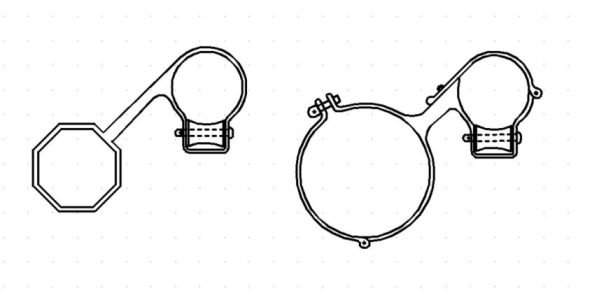
- Speedy, GrandpaPhil, Jeronimo and 4 others
-
 7
7
-
Continued: Clarifying the yardarms
After an extensive web search I came across this book: "Description de l'art de la Mâture" (published in 1778) by Charles Nicolas Romme.
Below are excerpts of the yardarms: Fig. 38 clearly explains the "oval" cross-sections in the area of the cleats on the yardarms.

In connection with the design of the yardarms for the La Créole, the question of the chronological classification naturally arises: The Le Rivoli is from 1810, the Le Sphinx from 1829 and the Le Neptune from 1836. In this respect, this is for the epoch of the La Créole applicable.
Apparently I'm not the only one who stumbled across this problem. So thanks again to G. Delacroix who gave me the crucial hint.
For my model, however, the question now arises as to how I can reconcile this detail with the drawings by J. Boudriot. I would prefer to stick to the original model. Unfortunately I don't have any meaningful detailed pictures. Ultimately, I will have to make a decision about this detailed design, even with the risk that it will not be entirely correct.
-
Thank you in advance for the valuable information.
I obviously misinterpreted the drawing by J. Boudriot. Now following your hint I see that it only works graphically as an oval.
I also researched my picture collection again and found a picture of the Le Neptune 1836 from the Musée national de la Marine Paris. A yard can be seen there as a reserve, comparable to that of the Rivoli.Allowed me to include your drawing and that of J. Boudriot in this example.
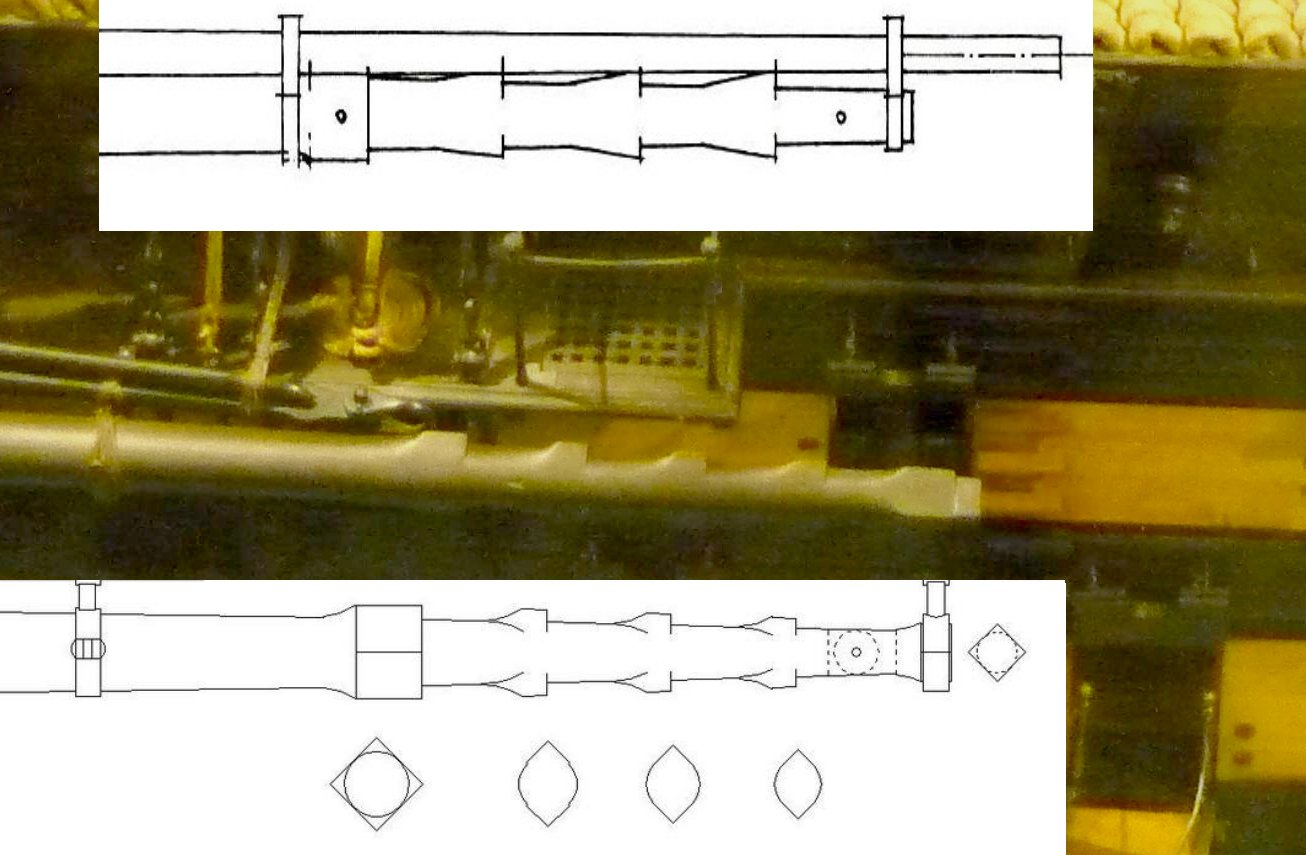
Source: Musée national de la Marine Paris, G. Delacroix, J. Boudriot
I also found a very interesting picture of a yardarm from the mizzen topsail yard of Le Sphinx 1829.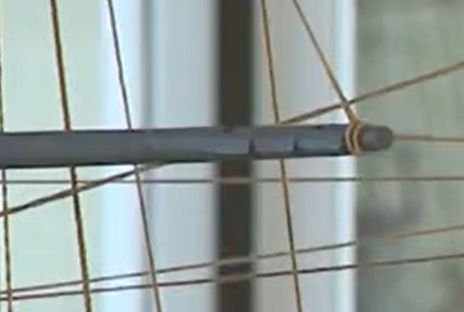
Source: Musée national de la Marine Paris
Will now try to make the yardarms of the topsail yards for the La Créole in the oval version according to the drawing by J. Boudriot.
I am very open and grateful for further hints and examples.
-
Continuation: Making the yards - Fore topsail yard - Vergue de petit hunier
After making the lower yards, I started working on the topsail yards. In contrast to the yardarms of other navies in the comparable period, the ones of the French navy seem adventurous. Probably due to a higher flexibility of the sailing maneuvers, these topsails are a certain challenge for the modeler, as can be seen on the following pictures for the mizzen topsail -, fore topsail - and main topsail yard of the La Créole.

Source: Monograph La Creole by J. Boudriot
Unfortunately, I do not have sufficiently sharp images of the original model from which one could derive further details. So I rely on the plan drawing of the monograph except for the formation of the studding sail booms at the yards of the mizzen mast. For this I again follow the original model, which clearly shows no studding sail booms at the mizzen mast. Further research shows that many contemporary French models also do not have studding sail booms at the yards of the mizzen mast. John Harland in his book "Seamanship in the Age of Sail" writes about studding sails on the mizzen mast that in his opinion they were neither popular nor particularly practical.
After several attempts, the fore topsail yard seems to have succeeded according to the drawing specifications, at least I am satisfied.The next picture shows the fore topsail yard compared to the main yard, where the yard arm has a simpler design.
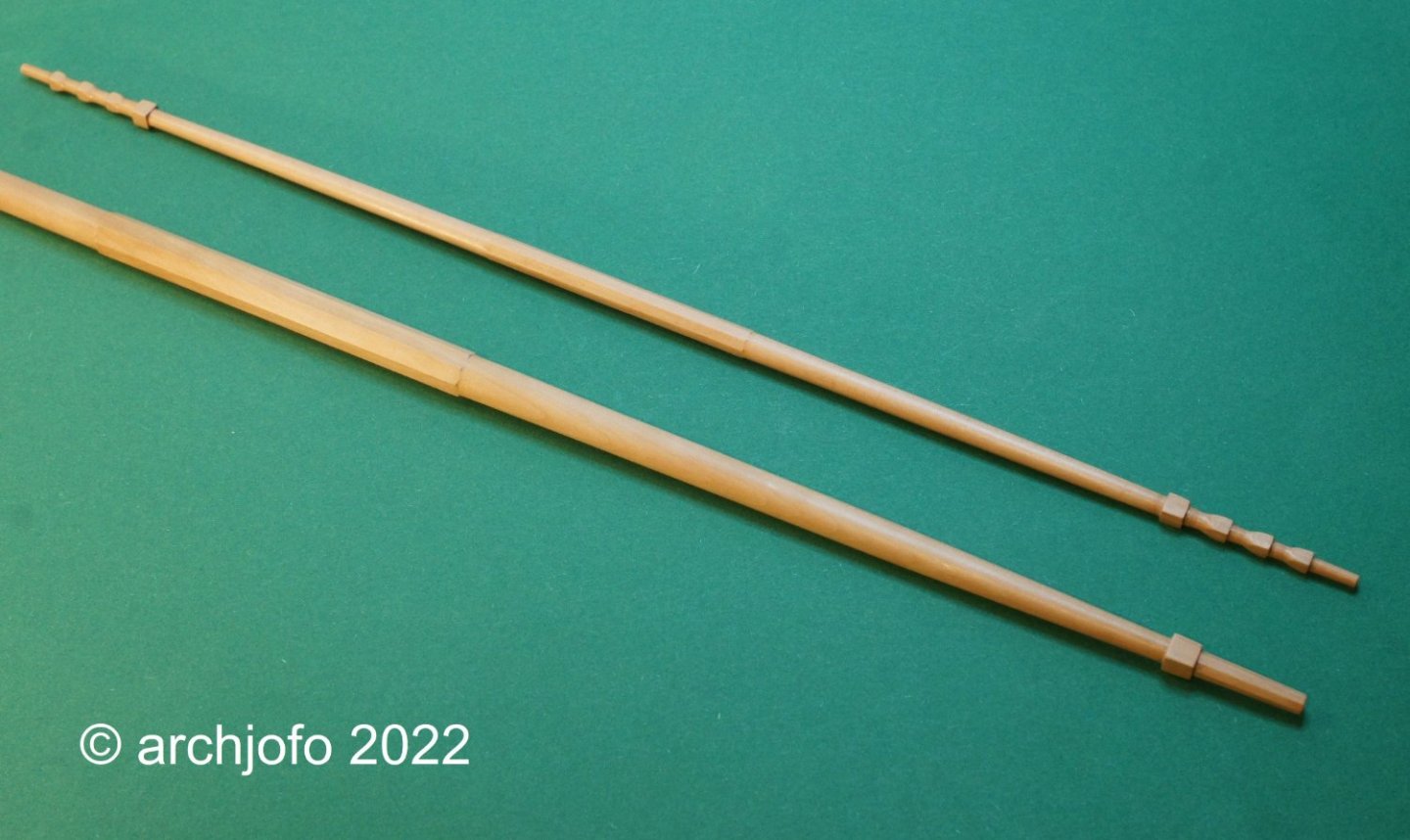
The drawing with dimensions for the main topsail yard is already available.
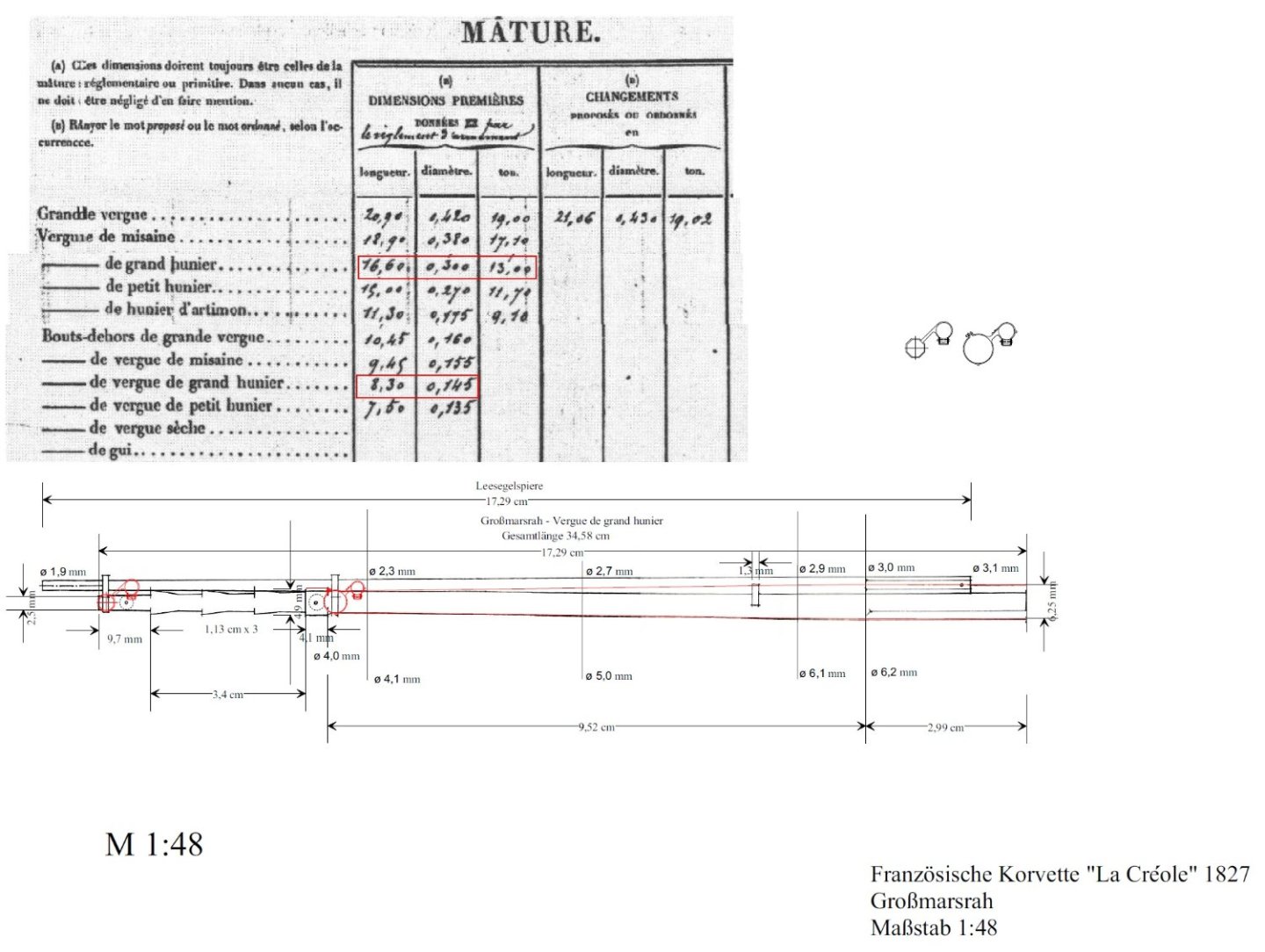
Soon it will go further ...
-
Hello Giorgio,
this will be a very nice model.
Very good work so far.- GioMun, mtaylor and Keith Black
-
 3
3
-
Hello,
I am very grateful for your interest and the nice comments, as well as for the many LIKES. That motivates immensely.
Continuation: Production of the yards - Vergues
We continued with the production of the yards. With the help of G. Delacroix I was able to clarify a few questions about the dimensions of the yards. Accordingly, I used the following table for the dimensions of the masts, yards and spars of the "La Blonde", which is identical in construction to the "La Créole".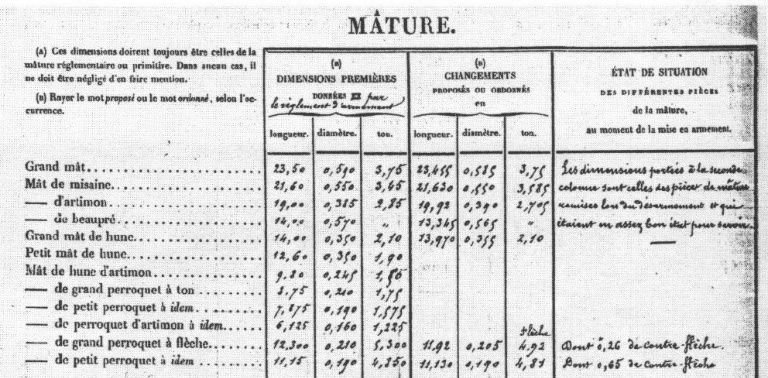

Source: Monograph on La Créole by J. Boudriot, page 56
There, among other things, the diameters are given in addition to the lengths. As a rule, the small diameter of a yard is 2/5 of the large diameter, as I could learn from G. Delacroix.
As you can see on the following pictures, the lower yards with the studding sail booms have been made so far in the meantime. Various details on the yard arms, such as for the installation of sheaves for the sheets still require final clarification.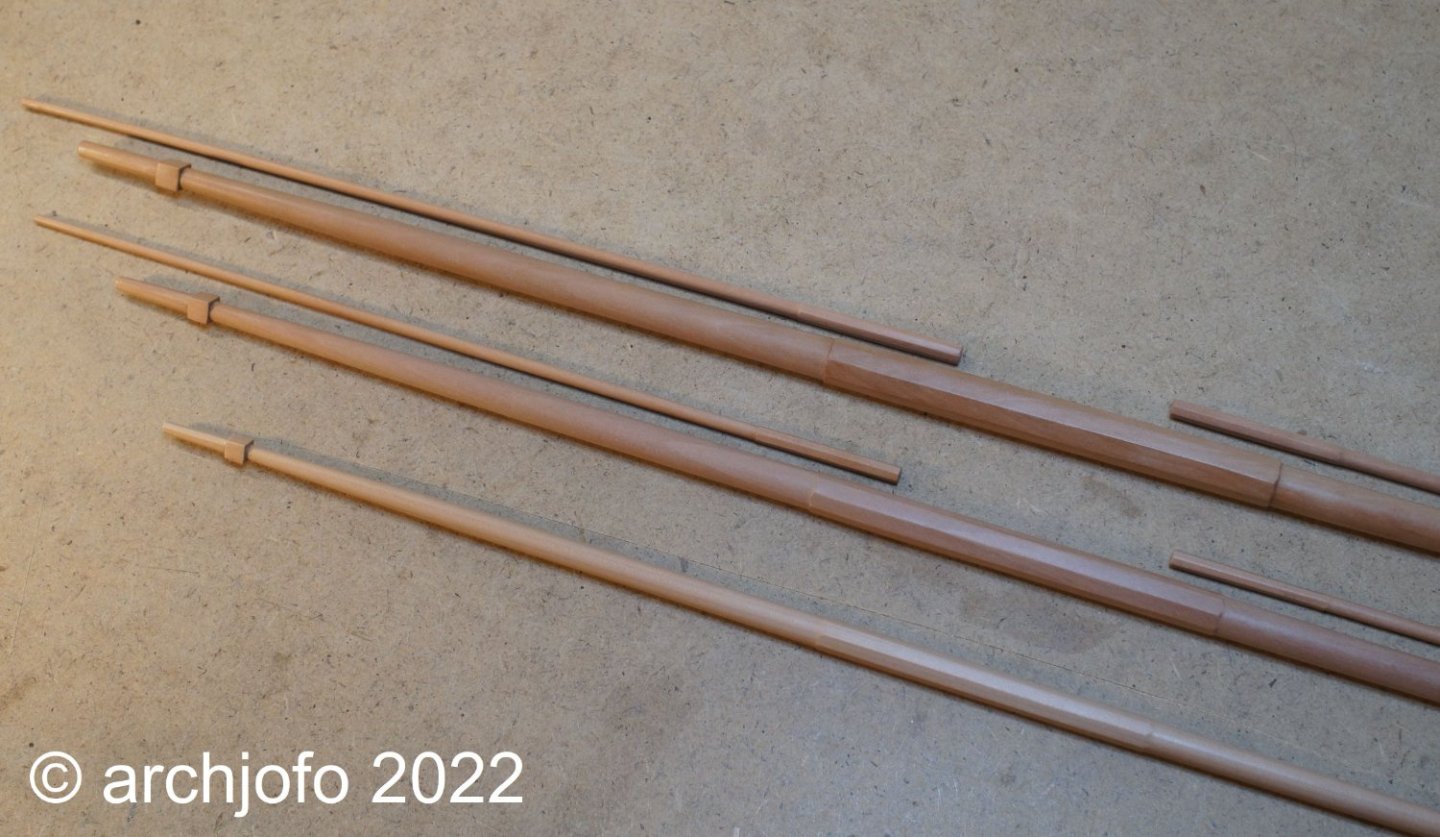
Also with the studding sail booms there are still questions about details, as shown in the following example of the model of the "Le Cotre 1830".
I would be very grateful for any suggestions and hints.Source: Modèles Historiques au Musée de la Marine - Volume 2 - Jean Boudriot
To be continued ...
-
It's hard to believe that this is 1:350 scale. To produce these tiny details so cleanly and accurately is worthy of special recognition.
A very nice modelship, congratulations.- mtaylor, Keith Black and GeorgeKapas
-
 3
3
-
Hello ,
very nice work, and good research. -
Hello Nils,
again really a beautiful model become, with all the many beautiful details.
Also the presentation will be fitting.- Mirabell61 and FriedClams
-
 2
2
-
Making the yards - Main yard - Grande vergue
Before starting to make the yards, I made myself a planing jig in advance, inspired by Ed Tosti's build report for the clipper "Young America" in the MSW, as shown in the drawing below. Rotating and locking clamps allow lumber of various widths and lengths to be fixed in place for machining, especially with a wood planer.
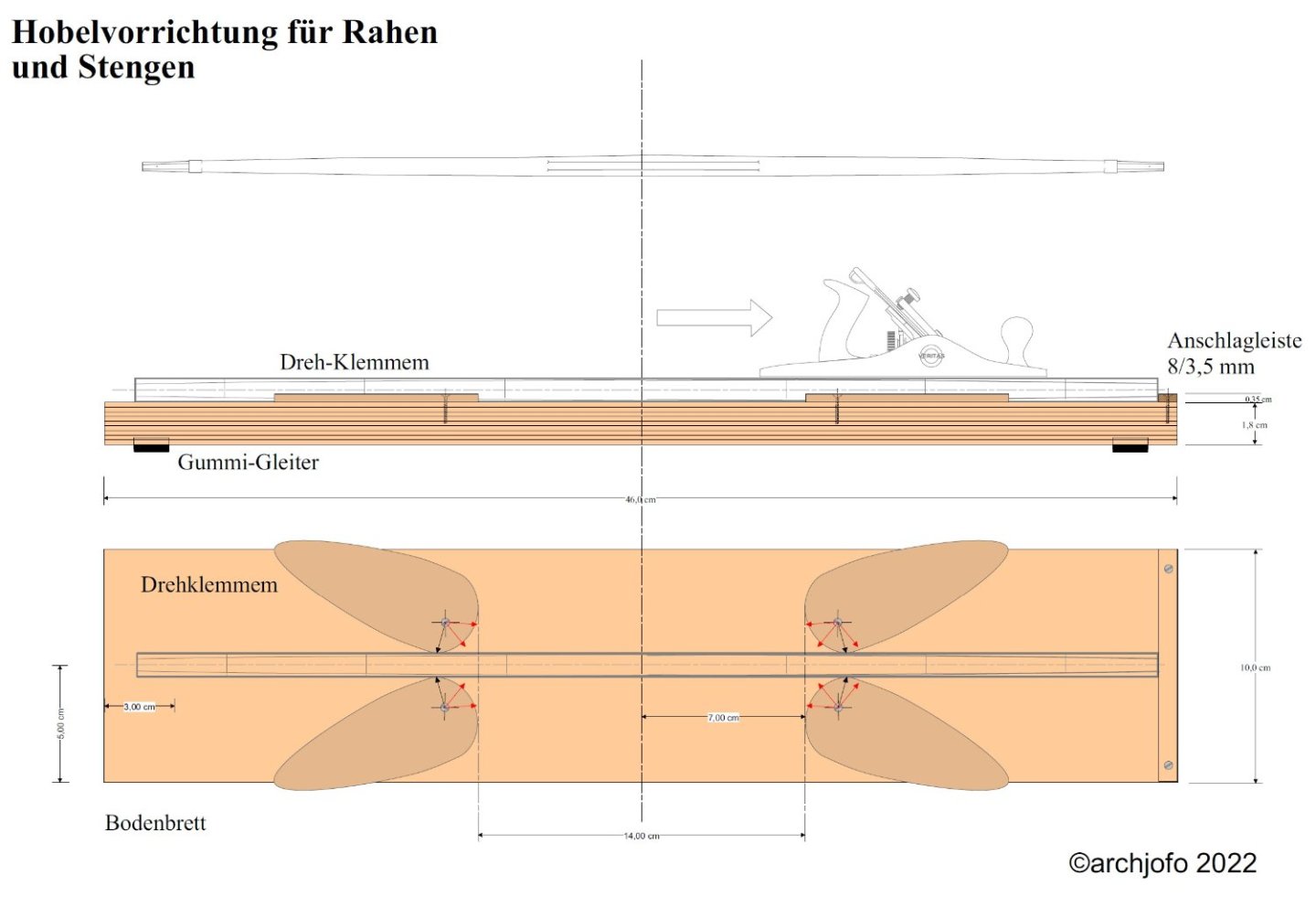
To make the main yard, I prepared a drawing with dimensions based on the plan by J. Boudriot.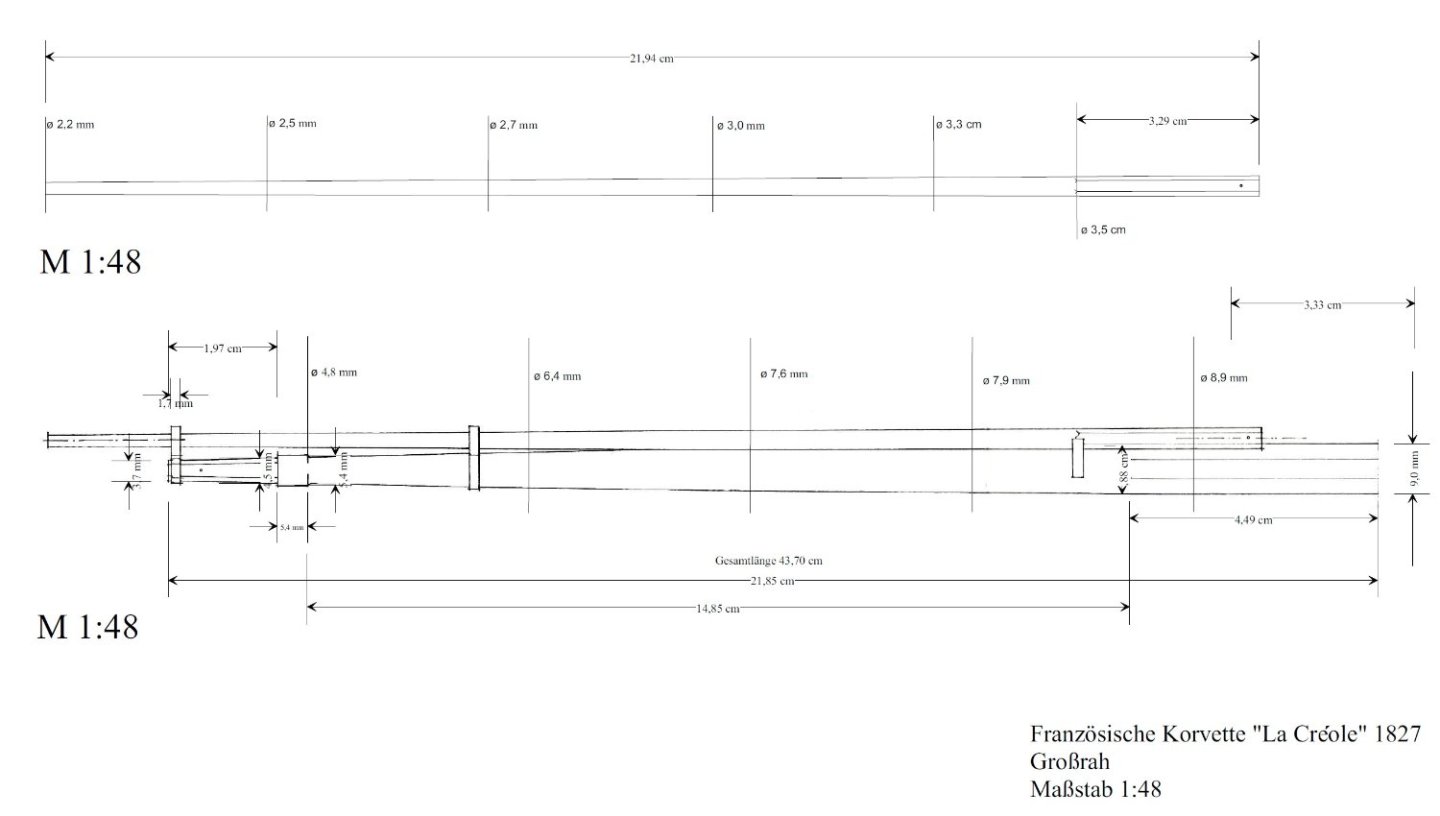
The next two pictures show how the holding device mentioned at the beginning of the report can be used in practice.
It performs valuable services in the manufacture of yards. For example, a wooden strip with a V-shaped groove was clamped in place. A square timber inserted in this way can easily be planed into an octagonal timber. In this case for the main yard and later for the leeward spars. These timber blanks are then much easier to machine on the lathe. In addition, they are used to roughly preform the octagonal areas of the yards or studding sail booms.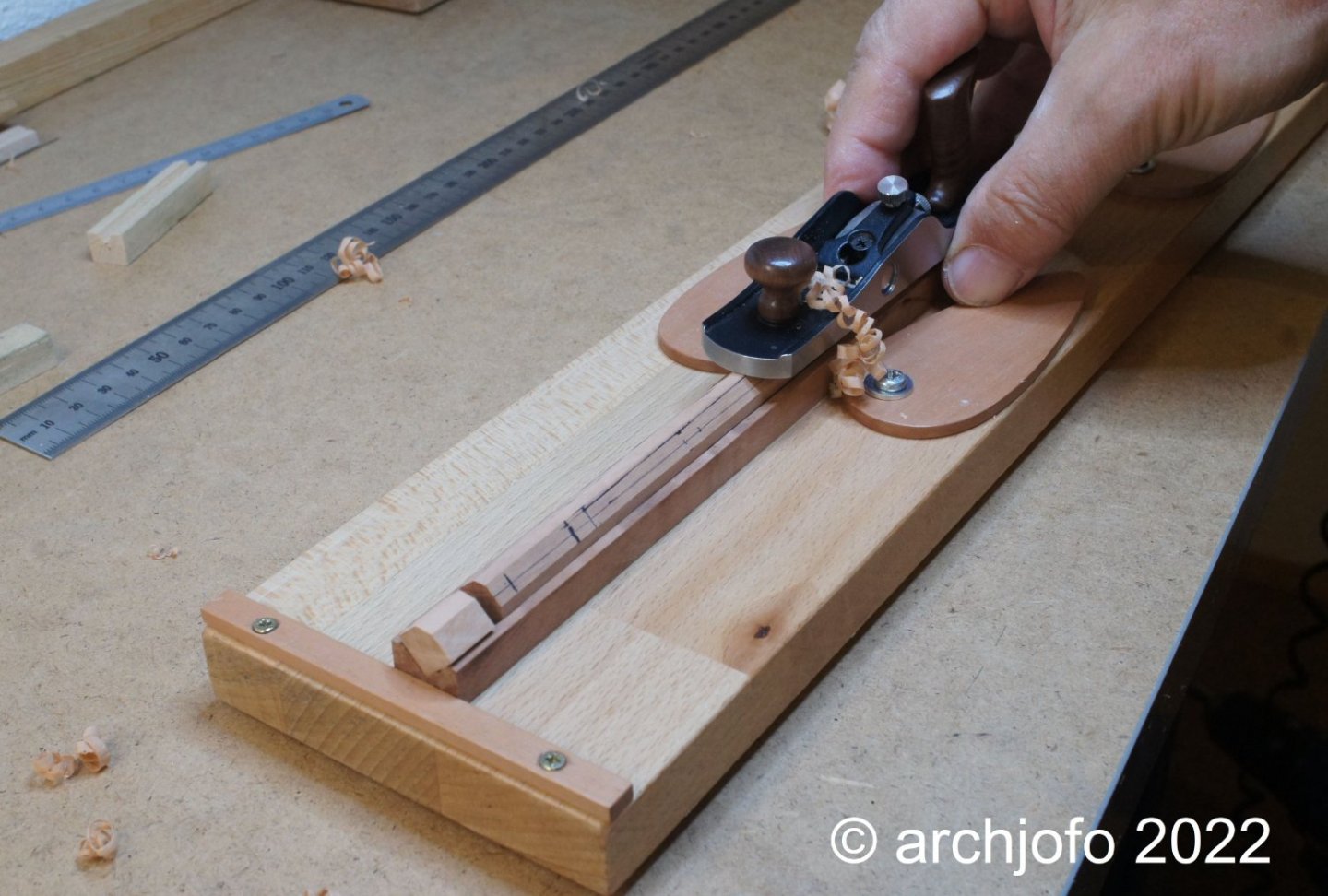
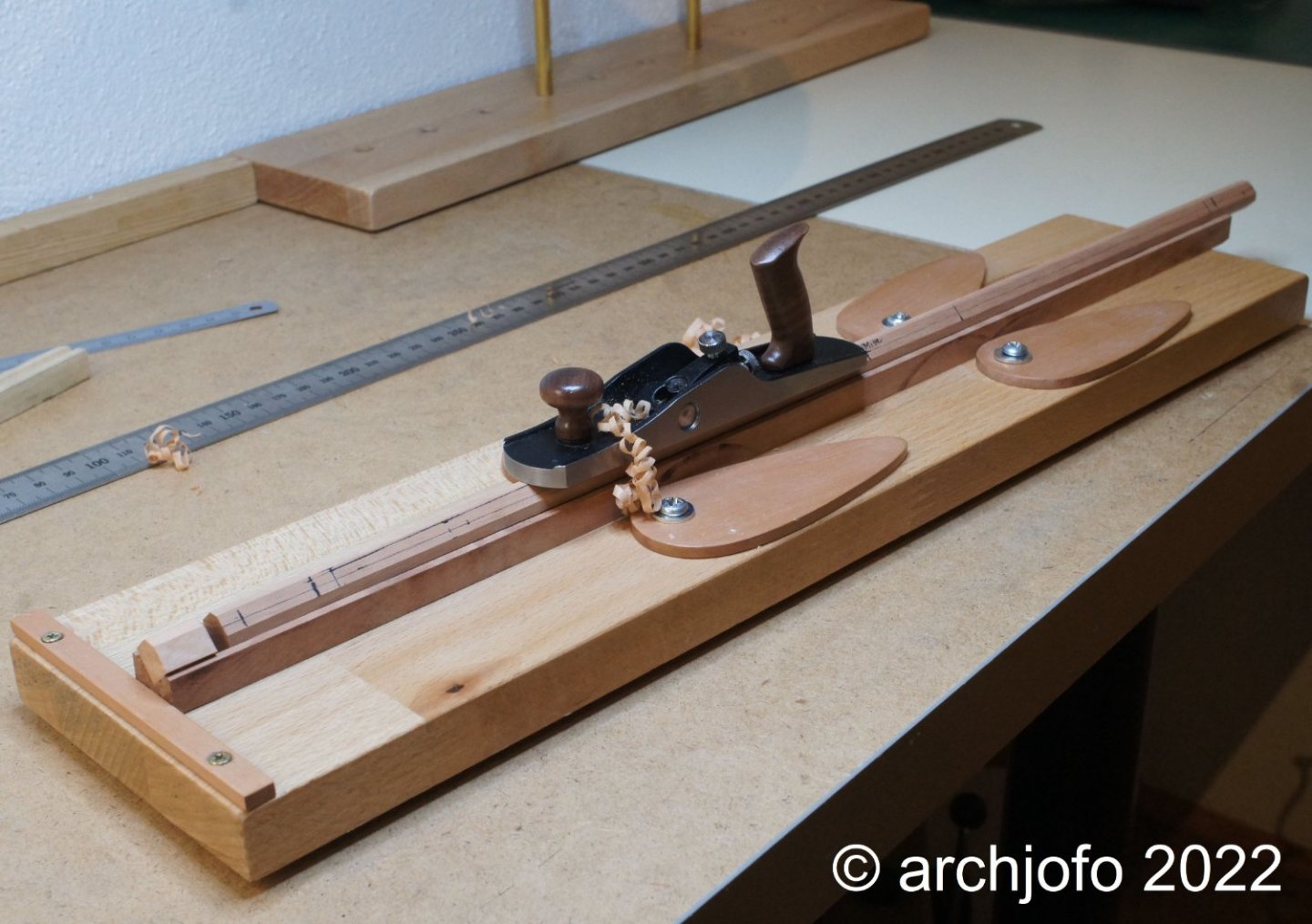
With the following pictures I illustrate the further processing steps in the yard production.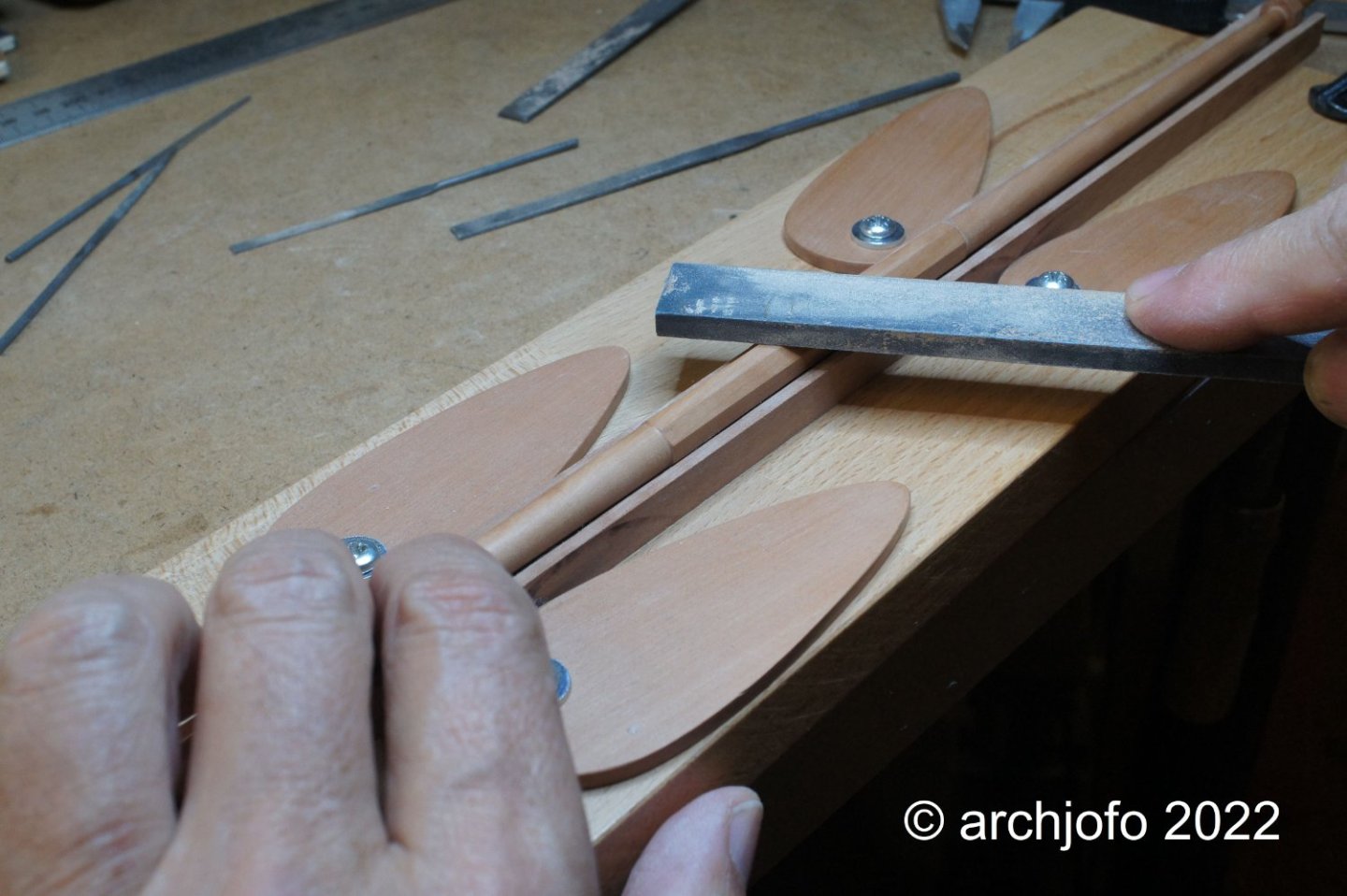
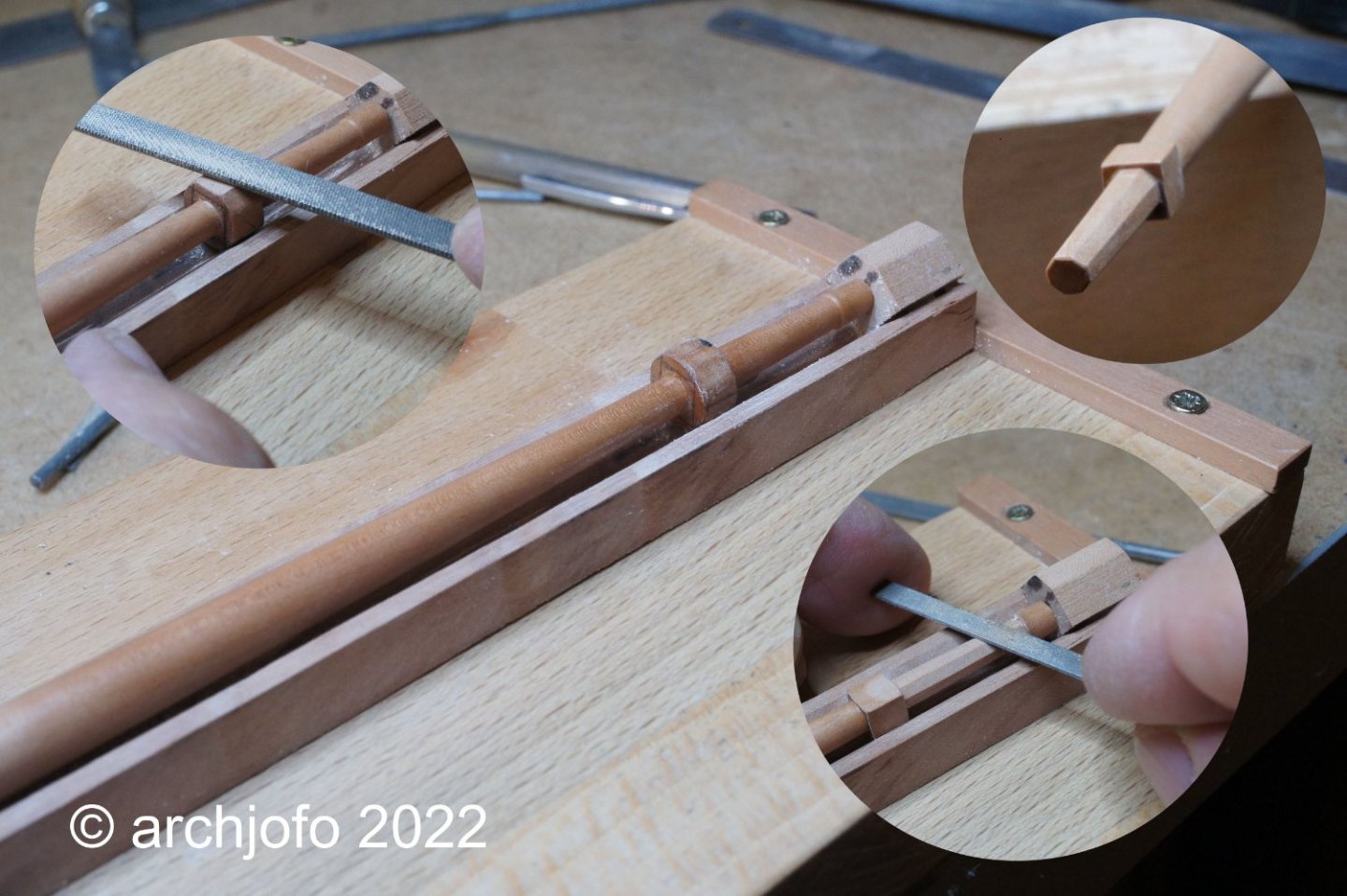
In contrast to the main yard, the studding sail booms are much more delicate logs with diameters of 3.7 to 2.2 mm, which had to be machined. So that this succeeds also without breakage, I built for this with simple means a small steady rest. With this I can bring small ball bearings for round timber with diameters of 1 - 10 mm into position for support. In the meantime, the small tool has already proven itself very well.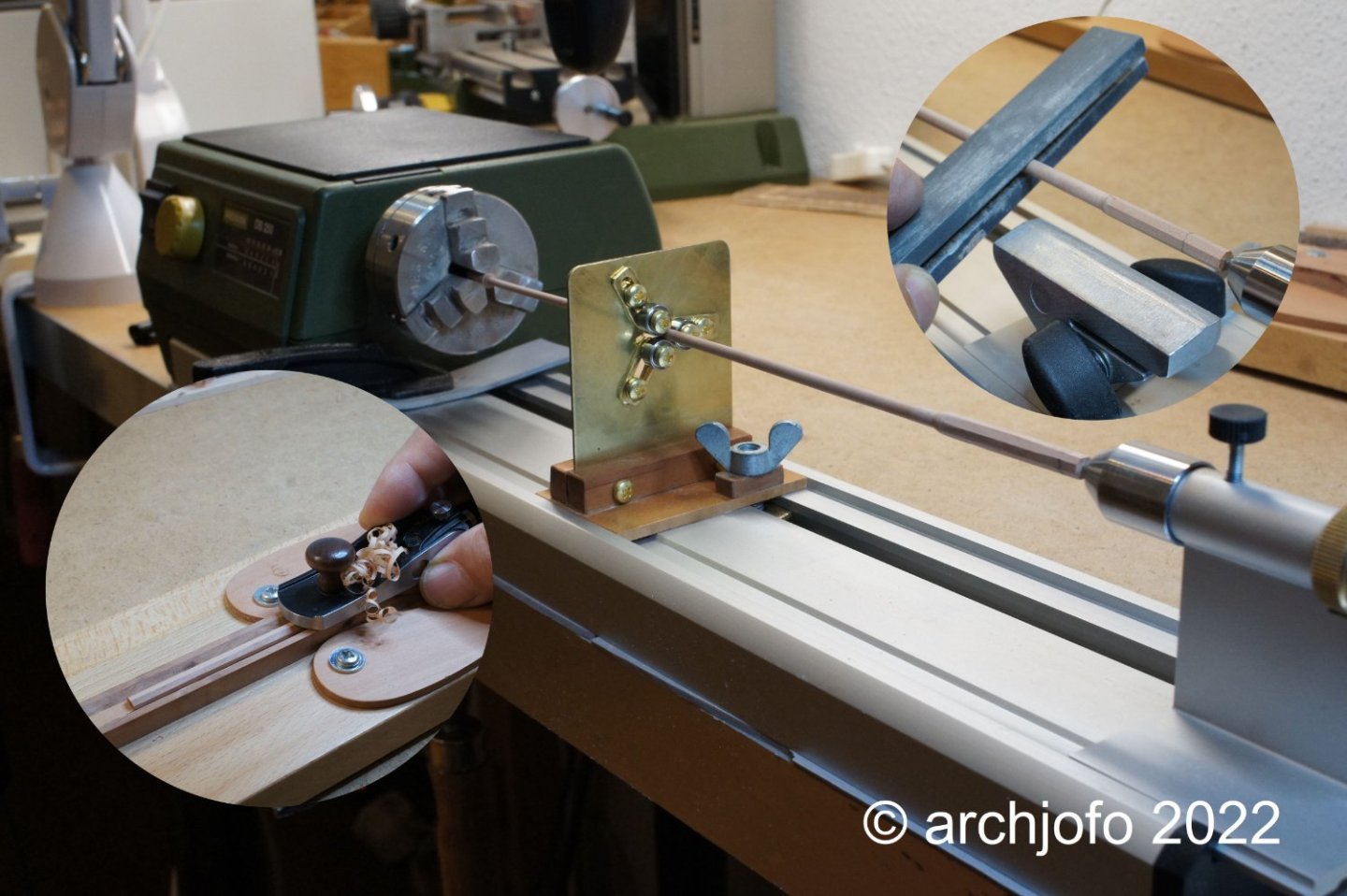
On the last picture you can see the first results.
- Paul Le Wol, scrubbyj427, druxey and 45 others
-
 40
40
-
 5
5
-
 3
3
-
-
Hello colleagues,
I am very pleased that despite a long break there is still interest in the progress of my model.
A hearty thank you for it.Completion: Standing rigging for jib and outer jib boom - Bâton de foc et bâton de clinfoc
After the final work on the standing rigging for the jib boom and the outer jib boom, I can also finish this chapter. So the standing rigging for the French corvette is finished except for a few minor details.
Accordingly, here are a few pictures that give an overview of the bowsprit rigging.
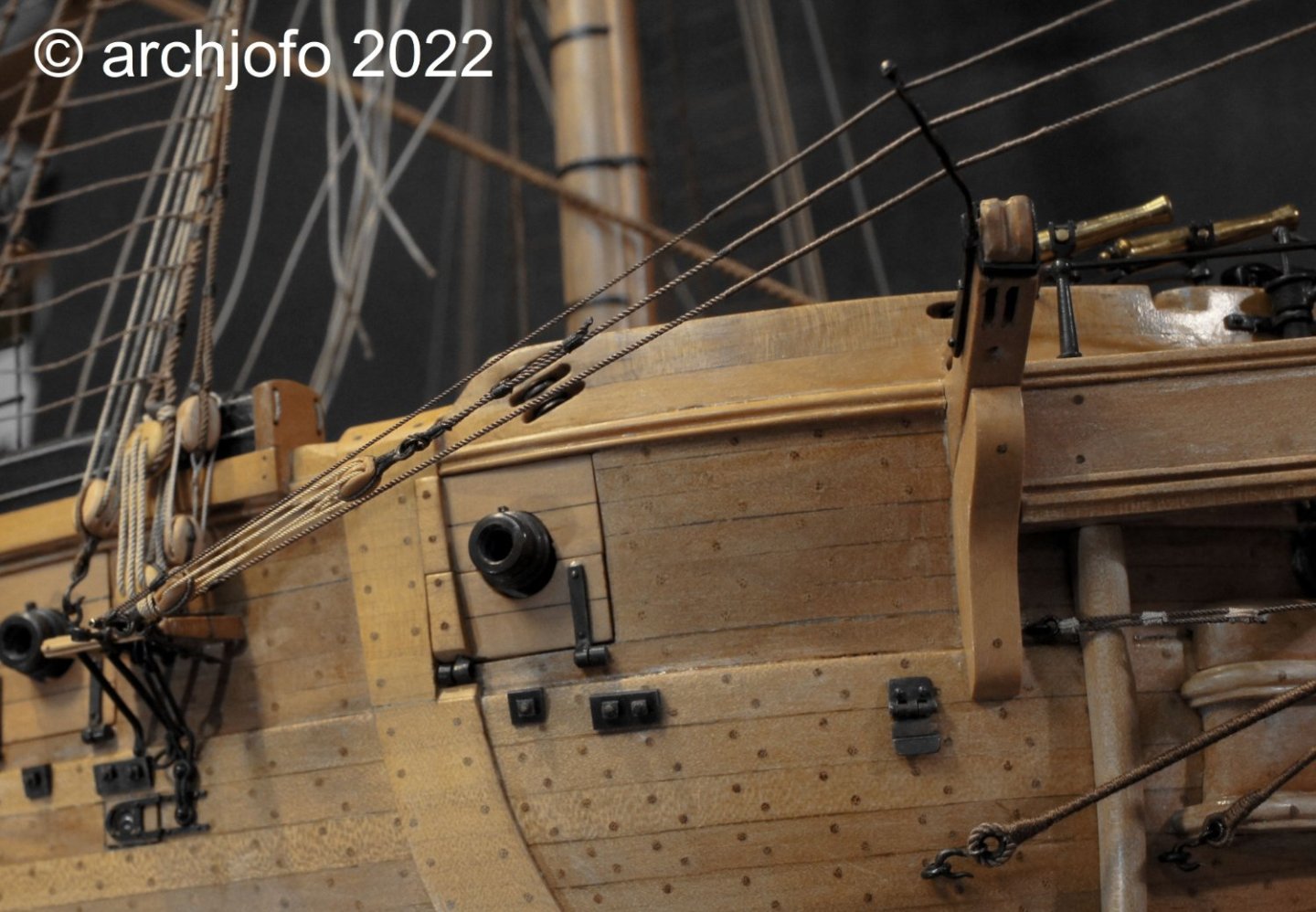
Soon I will dedicate myself to the production of the yards. So I am looking forward to work more intensively with wood again.
To be continued ... -
-
Hello,
you are right, but in this drawing I was only concerned with the connection of the guys by means of thimble. I based the tackle on the model of the L'Inflexible.
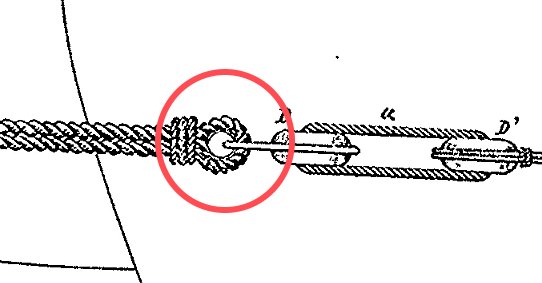
- Jack12477, FriedClams, mbp521 and 7 others
-
 10
10
-
Hello Brian,
almost finished !
This has become a wonderful model.
A lot of beautiful detail finishes.
Maybe you'll make it to the 160th anniversary after all.
Good luck.- mbp521, Keith Black, Canute and 1 other
-
 4
4
-
Thank you vor the kind words. And to all the others, thanks for the LIKES,
The days are getting shorter again, so the times spent in the basement shipyard are getting a bit longer again ... 😁
Continuation: Standing rigging for jib and outer jib boom - Bâton de foc et bâton de clinfoc
This is a continuation of my last construction report.
To finish the rigging work for the standing rigging of the bowsprit with the jib boom and outer jib boom, the jib boom and flying jib boom stays still had to be fastened. The jib boom was stabilized laterally with two jib guys on each side, one of which was fixed by means of a tackle.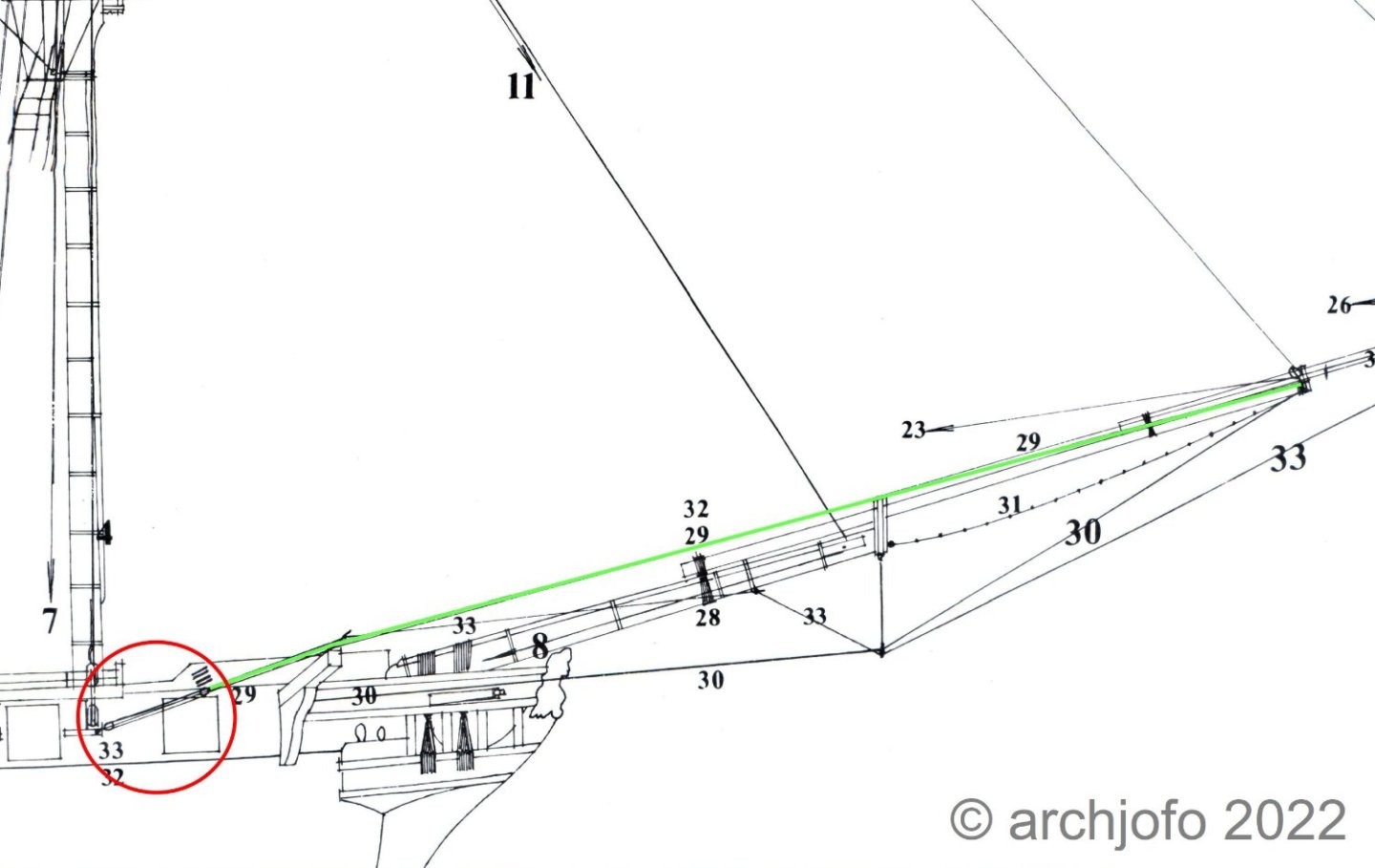
Source: Monograph La Creole by J. Boudriot p. 129For the detail of the tackle I followed the model of L'Inflexible and the Atlas du Génie maritime.
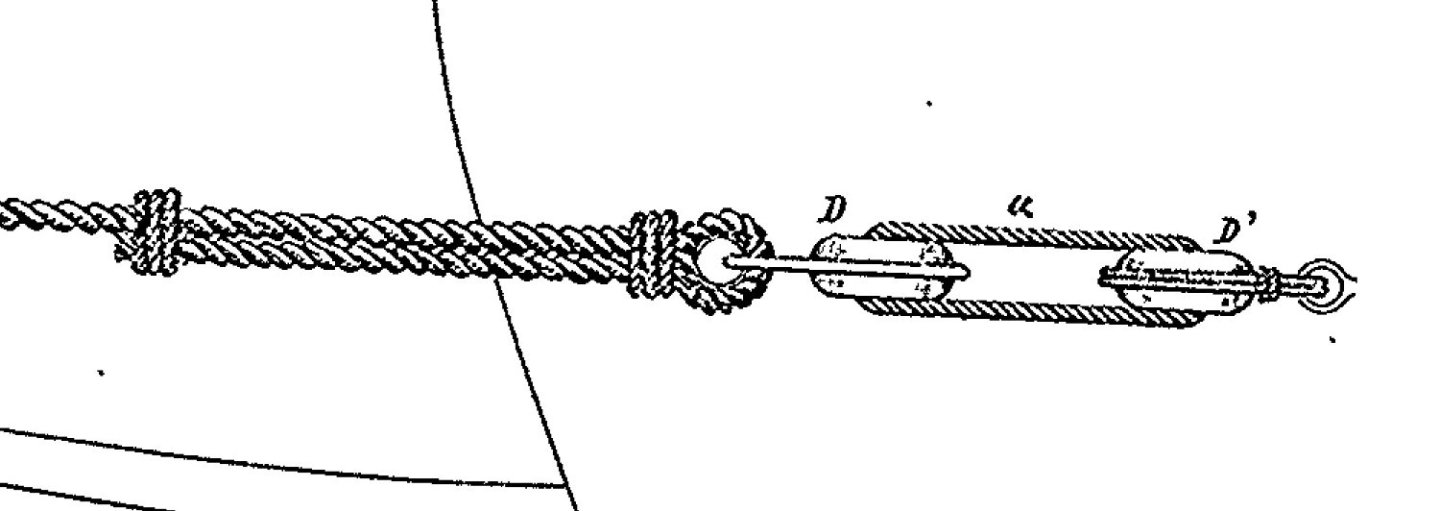
Source: Extract from Atlas du Génie maritime, annexe No. 1, Pl. 10Attached are two pictures of the implementation and the completed tackles, consisting of double blocks. The ends of the jib guys are then fastened by means of thimbles and seizings.
- matiz, bruce d, scrubbyj427 and 31 others
-
 34
34
-
-
Hello Greg,
the belaying pins look very realistic. A very fine shape.
In addition, the Speedwell will be a fantastically beautiful model. The beautiful woodwork is admirable.
The standing rigging of the lower masts also looks really great. I look forward to the progress of the work.- Tobias, dvm27, Ryland Craze and 2 others
-
 5
5
-
First of all, I would like to thank you very much for the interest in my work and the nice comments. Also I would like to thank you for the many LIKES.
Continuation: Standing rigging for jib boom and flying jib boom - Bâton de foc et bâton de clinfoc
On a grommet strop (ring rope) as a base, the standing rigging for the jib boom was laid on top. Building on this, first come the footropes, which are slipped over the boom with a served cut splice. At both ends the footropes had a served eye for tying to the top of the bowsprit at the back eyebolts, to which the single blocks for the bowlines of the fore top sails were also attached.
In order to guarantee the sailors a secure hold during their work, knots were worked into the 22 mm (ø 0.46 mm in model scale) thick rope of the footropes at intervals of two feet, e.g. as Turkish head knots. In 1:48 scale, I think it seems quite sufficient in this case to make overhand knots.
After the abolition of spritsail yards in the 19th century, the jib boom guy and flying jib boom guy were often spread to the cathead by means of iron outriggers, thus giving the jib boom and flying jibboom greater strength laterally. Accordingly, this was also the case with the La Créole. The rigging was mounted on iron spike-like outriggers on the fore channels.
In principle, the jib boom guys perform the same function as the shrouds, hence their designation by the French, such as Haubans bout-dehors beaupré, which corresponds to the jib boom guy.
The jib boom of this corvette had two 22 mm dia. ropes on each side, one of which was stiffened with tackles and double blocks.
The jib boom guys were attached individually with served eyes to the top after the footropes, and as already described, led through the outriggers to the cathead to the fore channels for mooring. The area of the lead through the booms was served against rubbing.
Next came the jib boom stay, also a 22 mm dia. rope. This was slipped over the top with a served eye and attached to the iron martingale in a groove provided for it. Underneath, the two jib boom stays were slipped over as counterparts, which were then attached to eyebolts on the port and starboard sides of the bow.With the already shown triple block for the bowlines and the fore topgallant stay, the rigging of the jib boom came to an end.
The following picture shows the rigging elements that were partially mentioned before.
The second picture shows the finished jib boom top. After all, six ropes have been laid there, as well as the grommet and the triple block strop.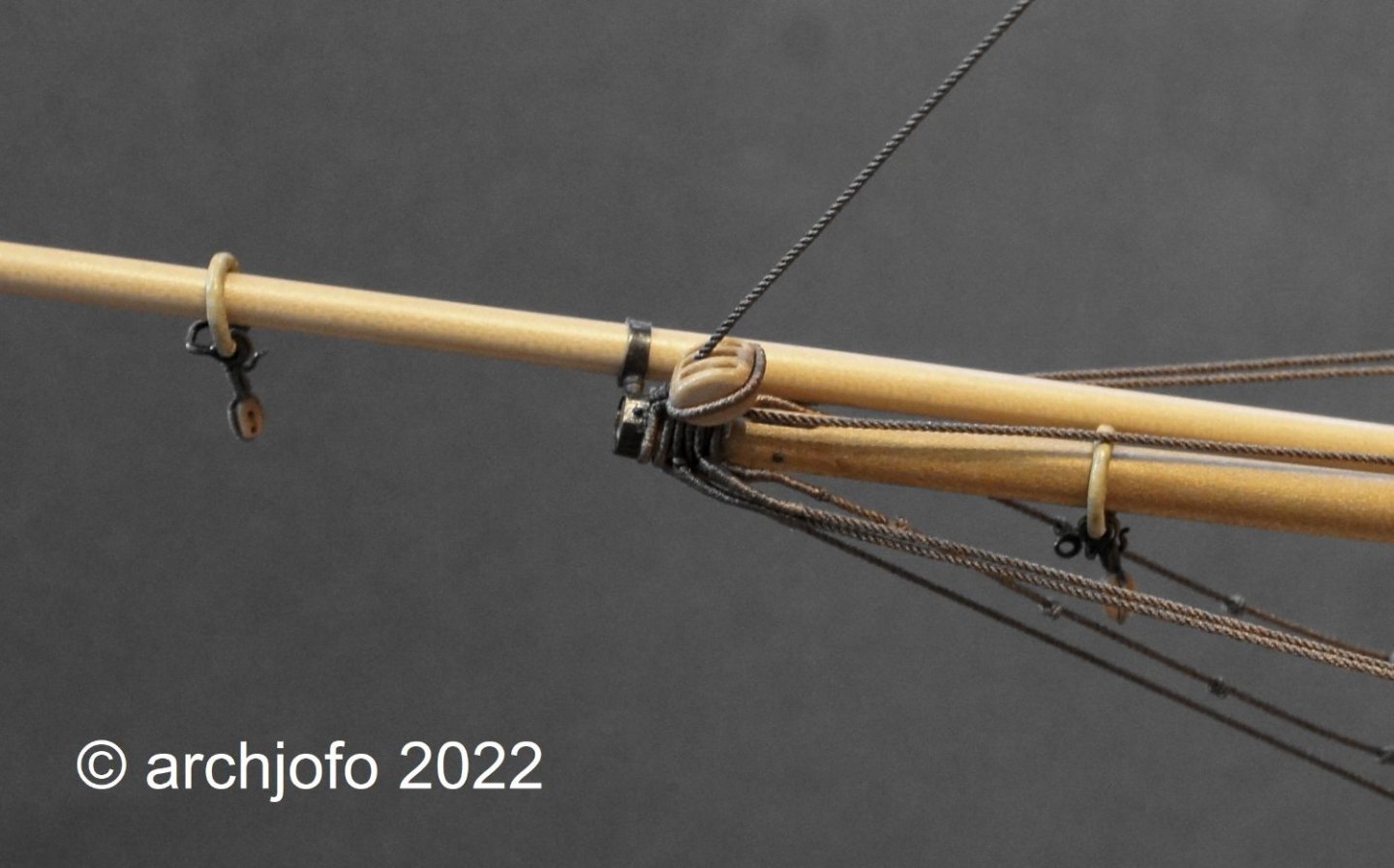
And in the last step, the flying jib boom was rigged, as can be seen in the last picture.
Building on the grommet, the following ropes were stripped over the flying jib boom top:
- footrope ø 19 mm (ø 0.40 mm in model scale)
- flying jib boom guys ø 22 mm (ø 0.40 mm in model scale)
- pair of flying jib boom guys ø 19 mm
- strop with 2 thimbles for the bowlines
Finally, the fore topgallant stay ø 15 mm (ø 0.35 mm in model scale) could be passed through a disc in the flying jib boom top and fitted in the forecastle.See you soon ...
-
Hello,
Thank you in advance for your nice comments and the many "likes".
I am always happy and motivated by positive feedback. Constructive criticism and suggestions are still very welcome.Greg, I'm also very glad that my rigging inspires you.
Continuation: Standing rigging for jib and outer jib boom - Bâton de foc et bâton de clinfoc
First I had to attach the jib boom. I lined the jib boom passage in the cap of the bowsprit with a specially split leather (d=0.2 mm). The jib boom was placed on the prepared wooden pad or spacer so that it runs parallel to the bowsprit. Then I lashed the jib boom to the bowsprit analogous to bowsprit gammoning.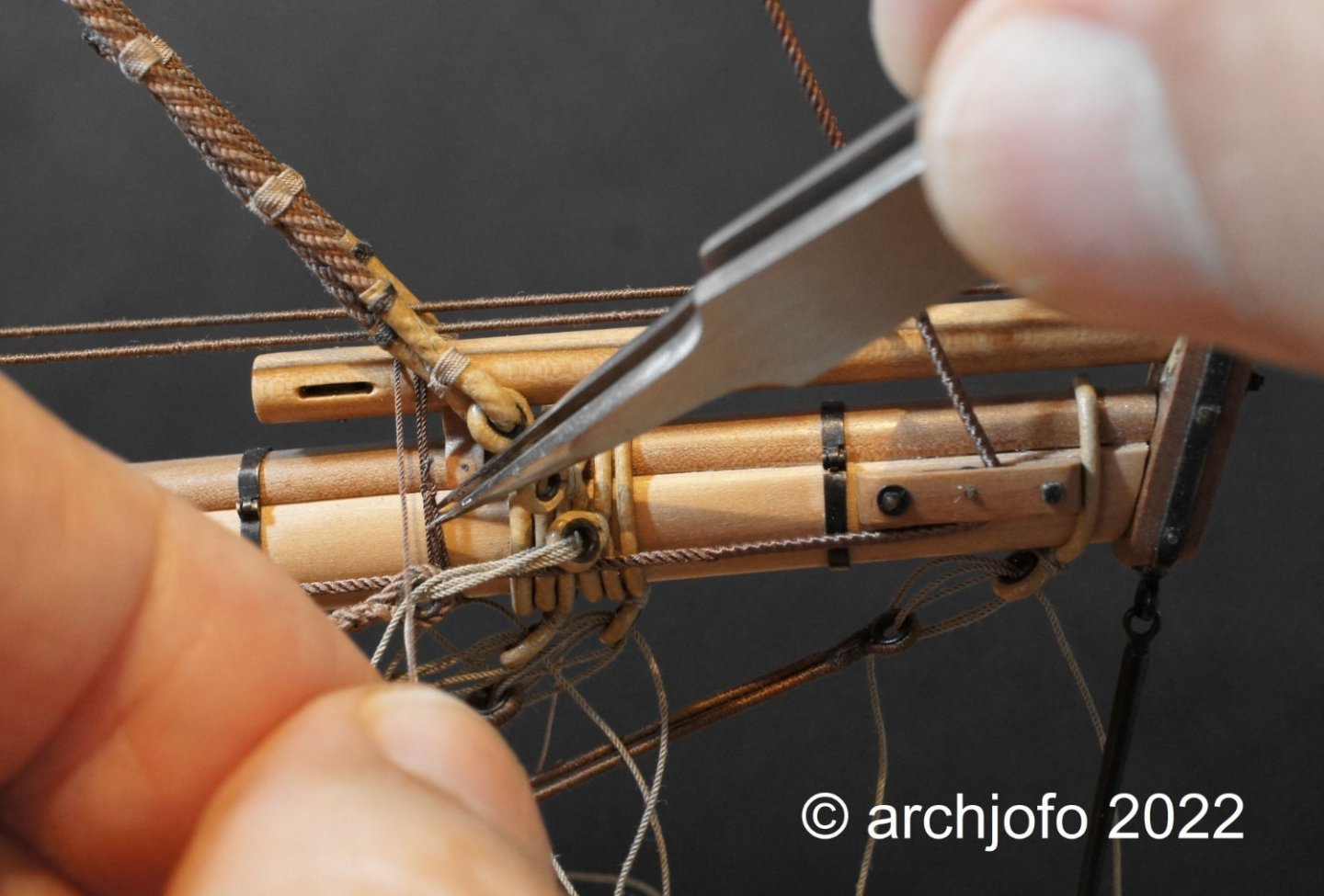
I added small details to the cap, as can be seen in the last picture. These are single blocks (l = 3.5 mm) on each side for the bowlines of the fore topsail. Next to the block you can also see the leather lining mentioned at the beginning.- mtaylor, G. Delacroix, Dziadeczek and 37 others
-
 32
32
-
 8
8



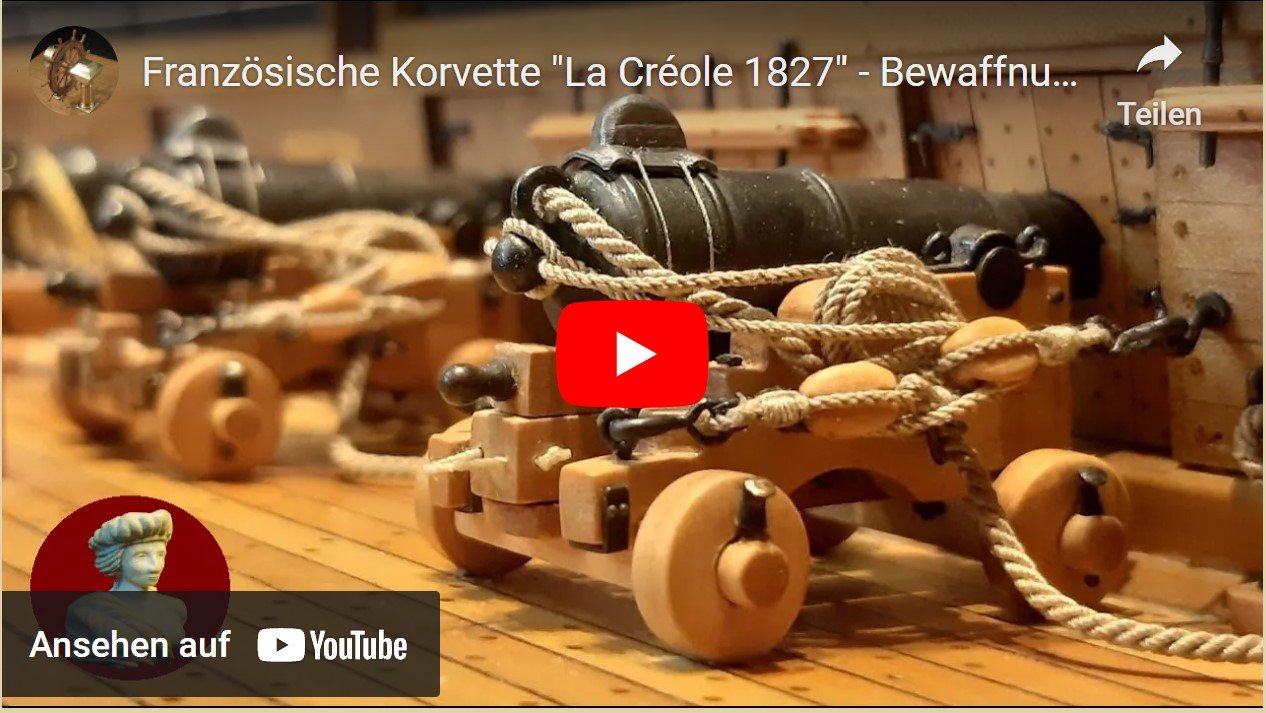
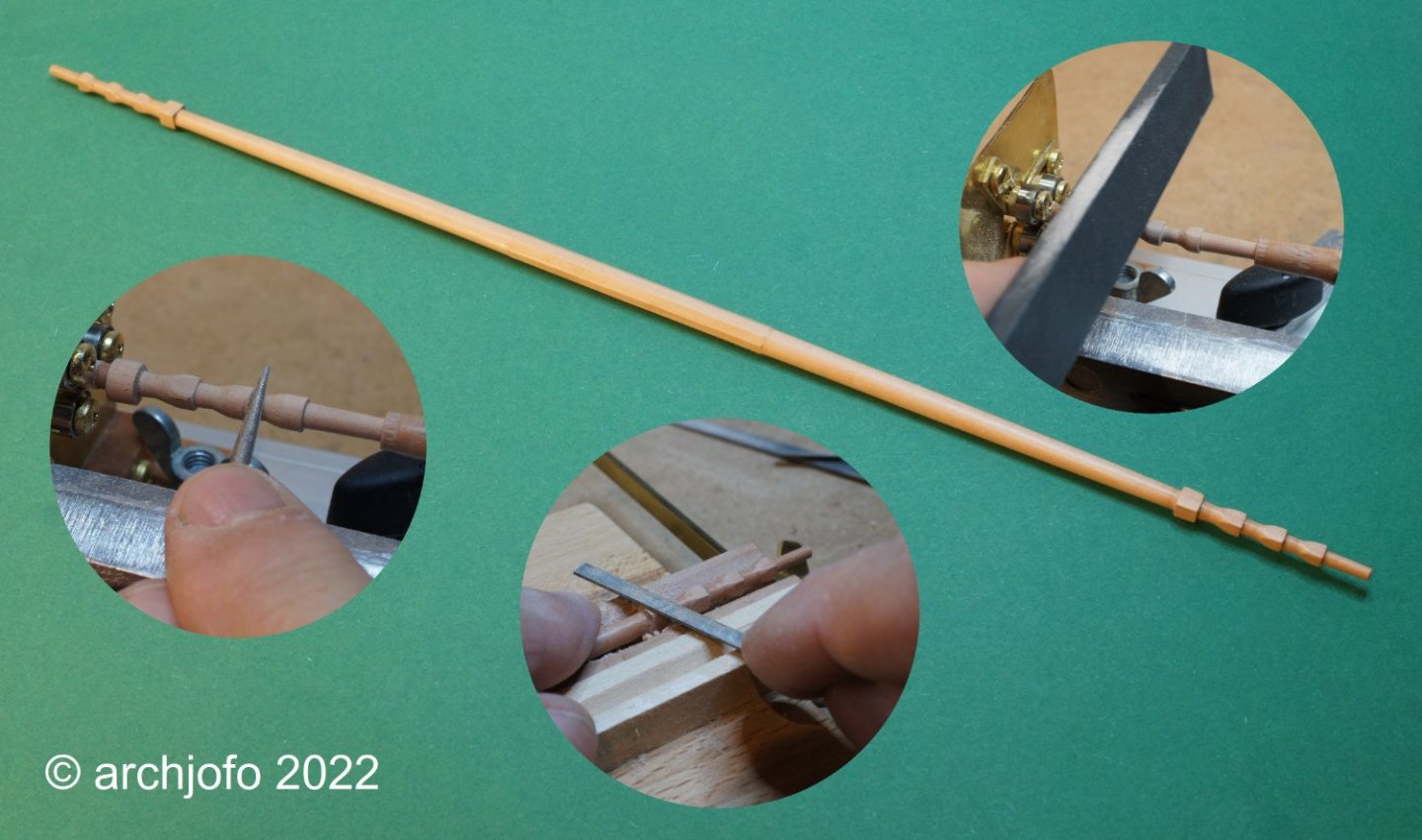
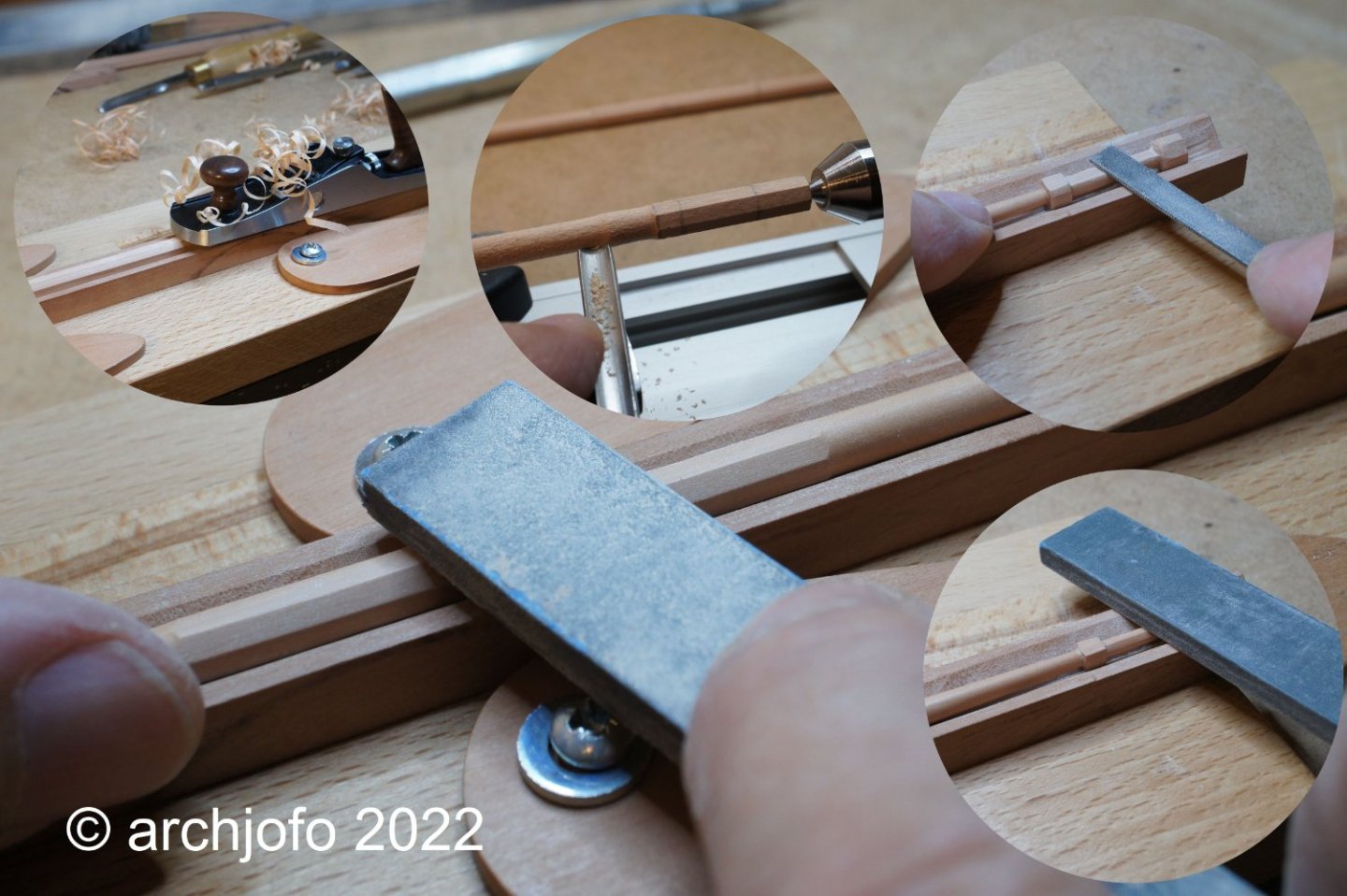
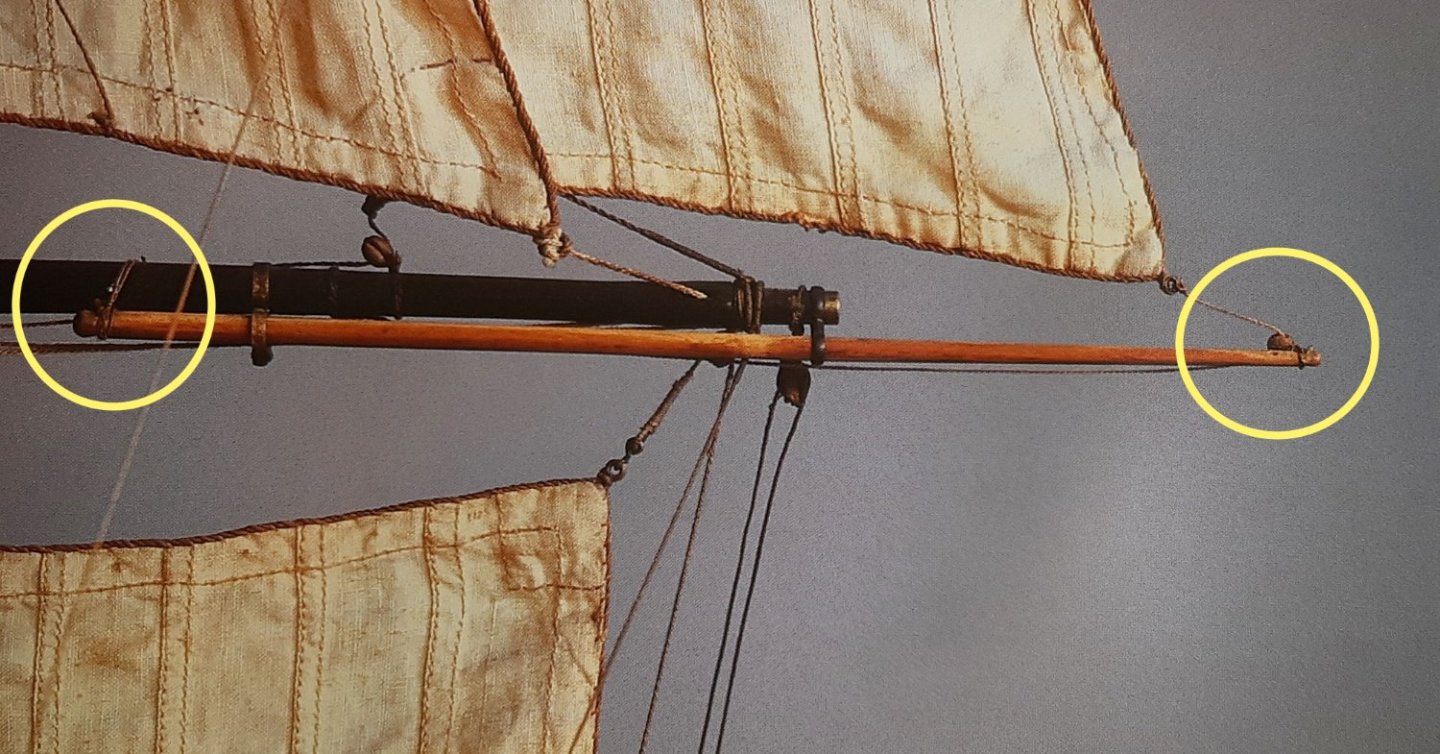
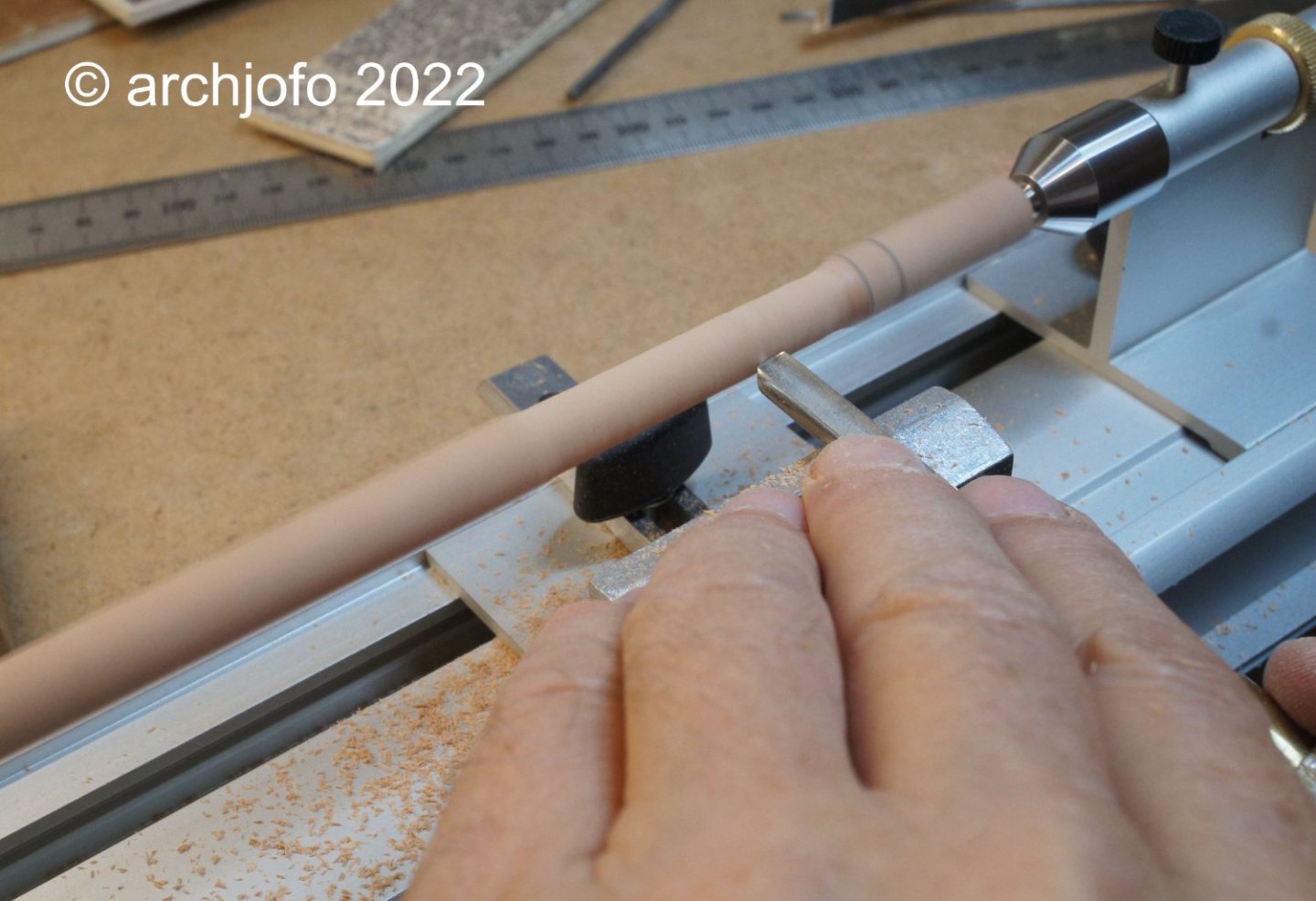
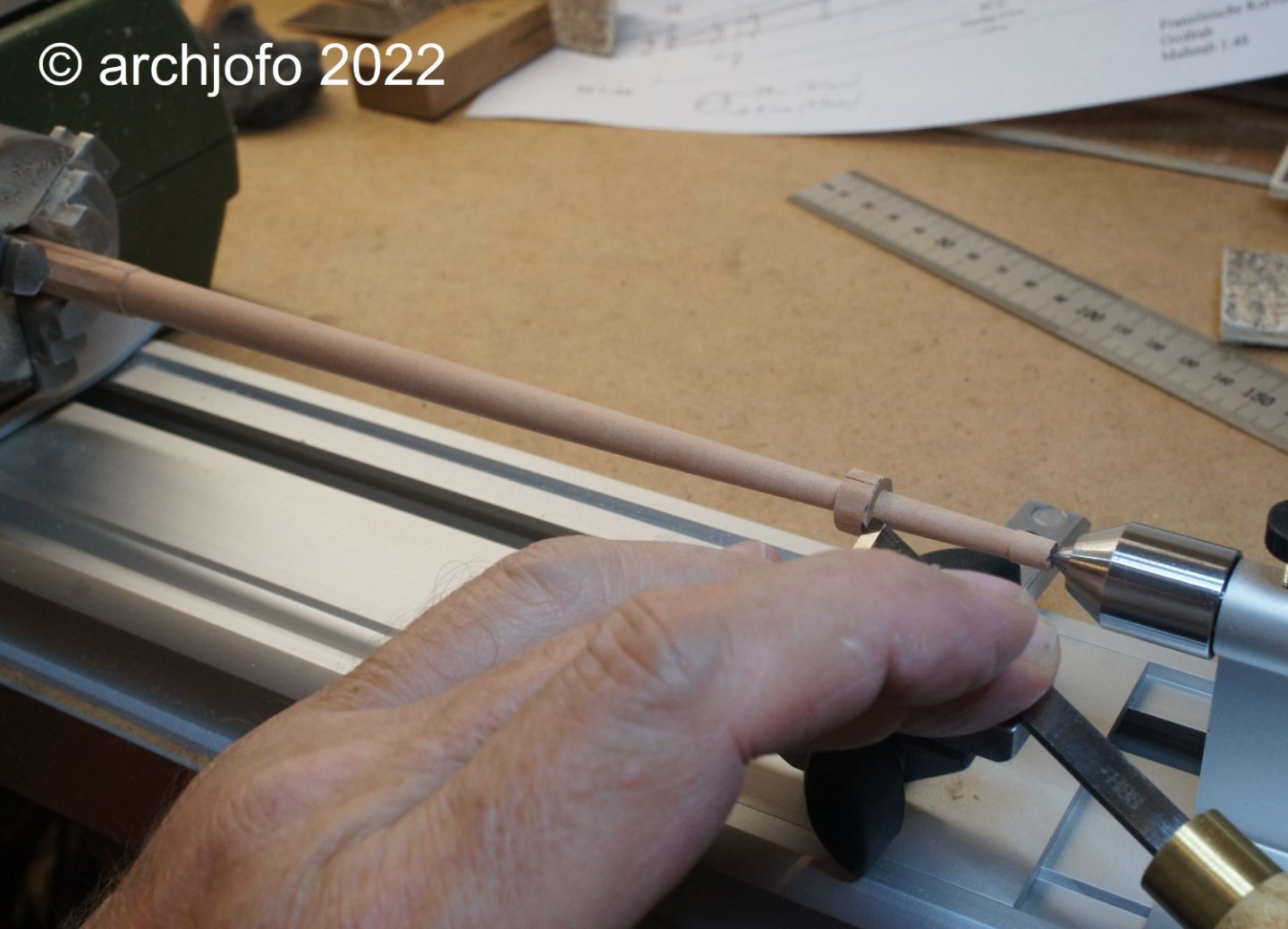
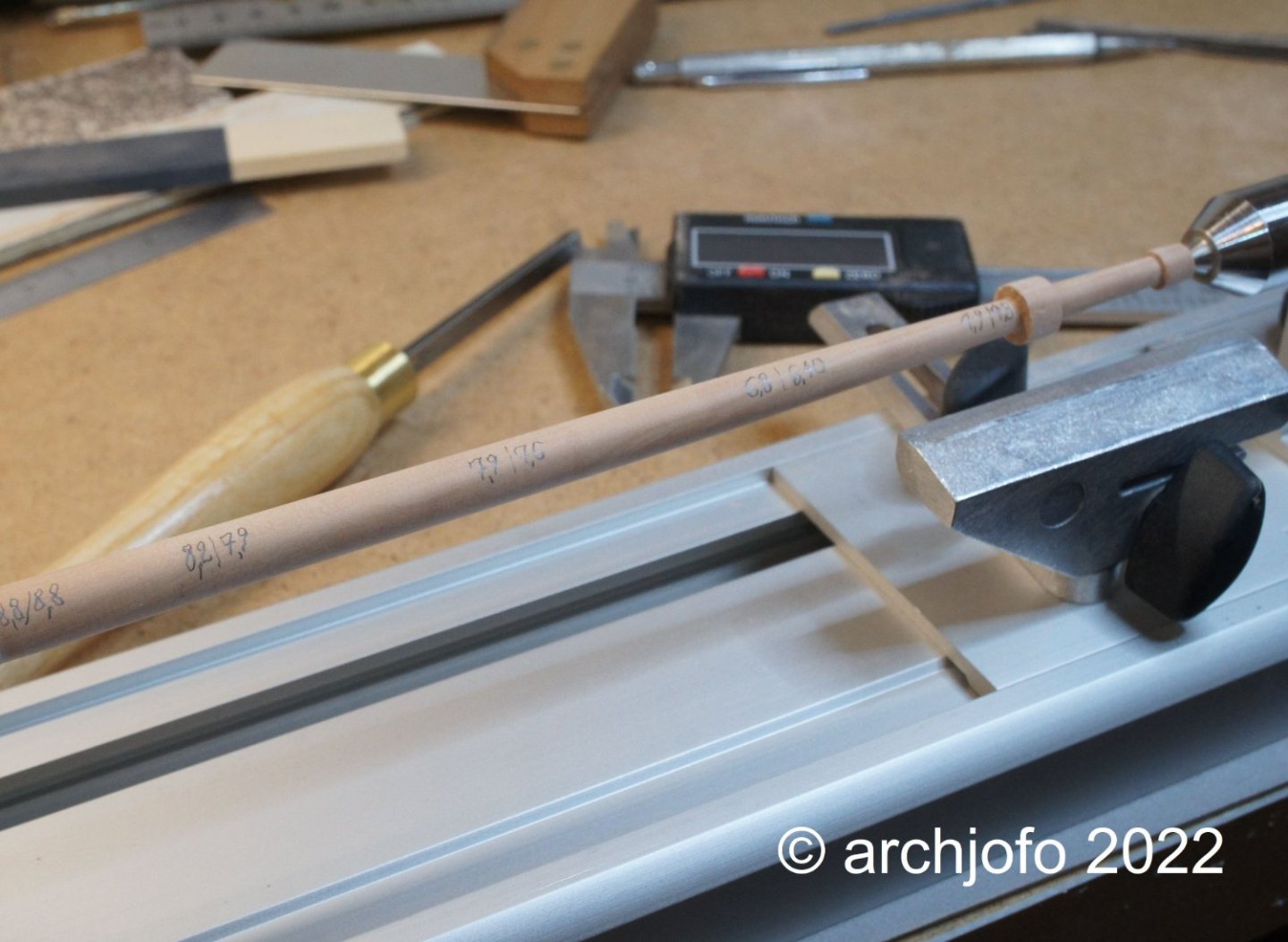
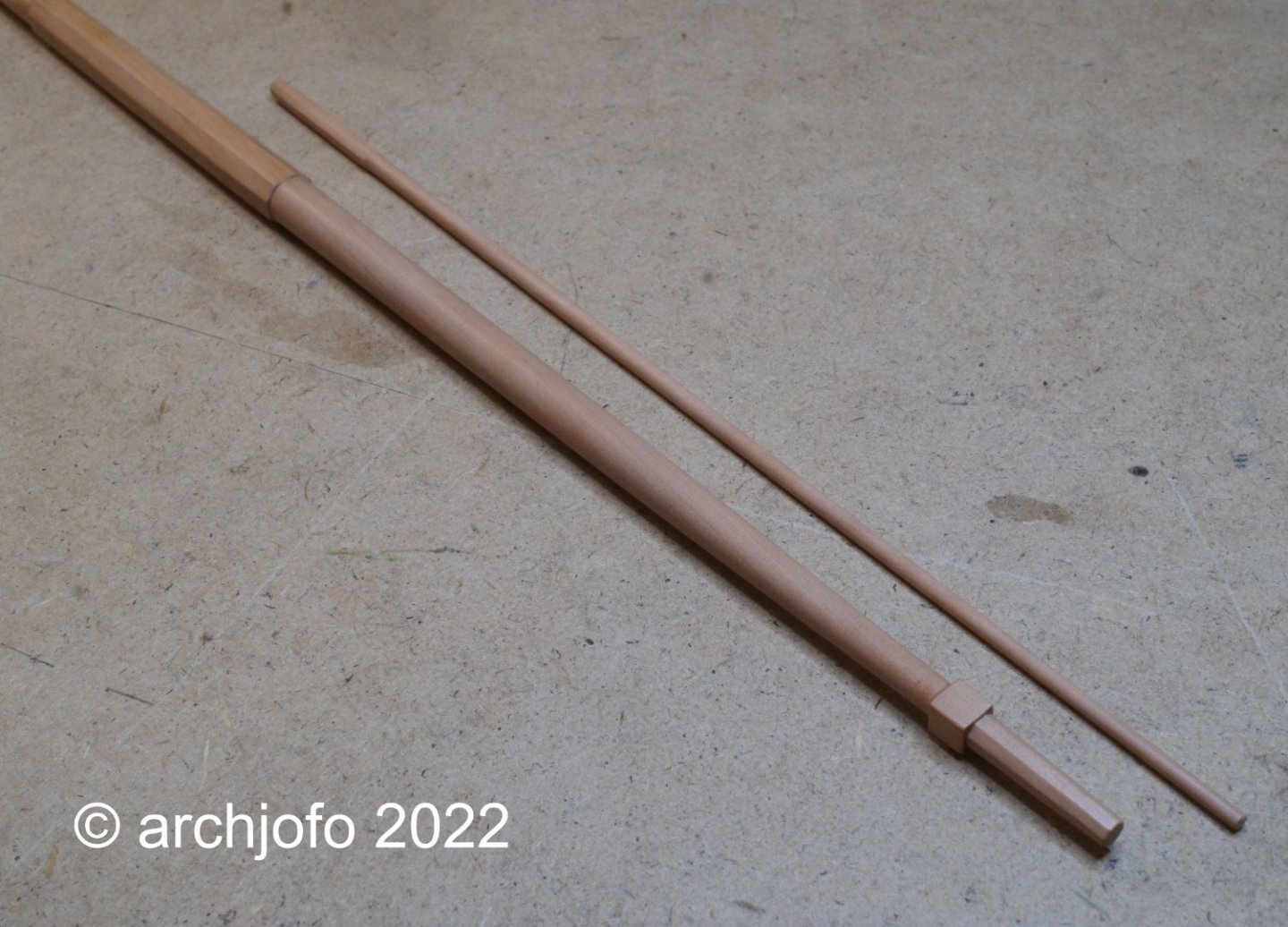
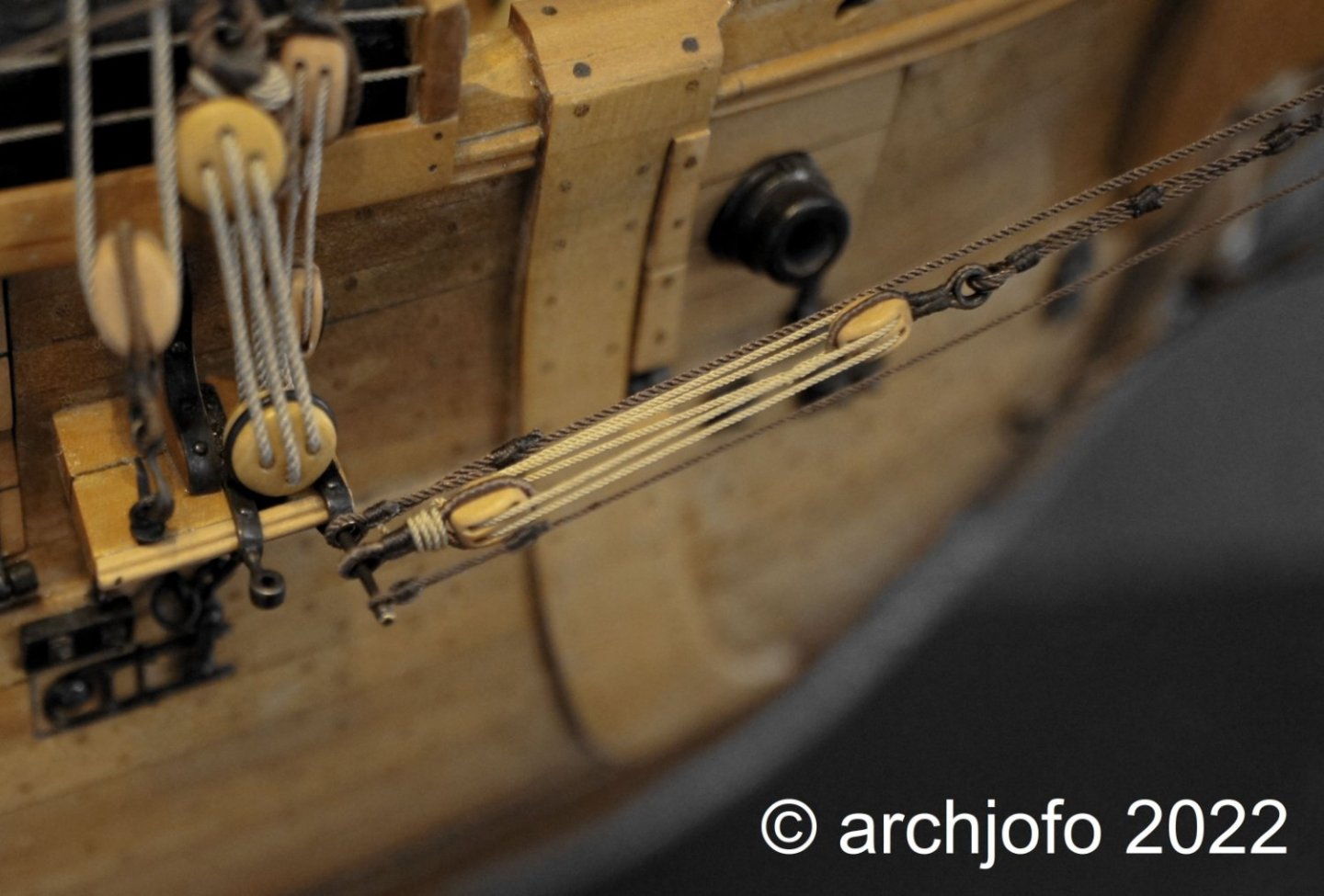
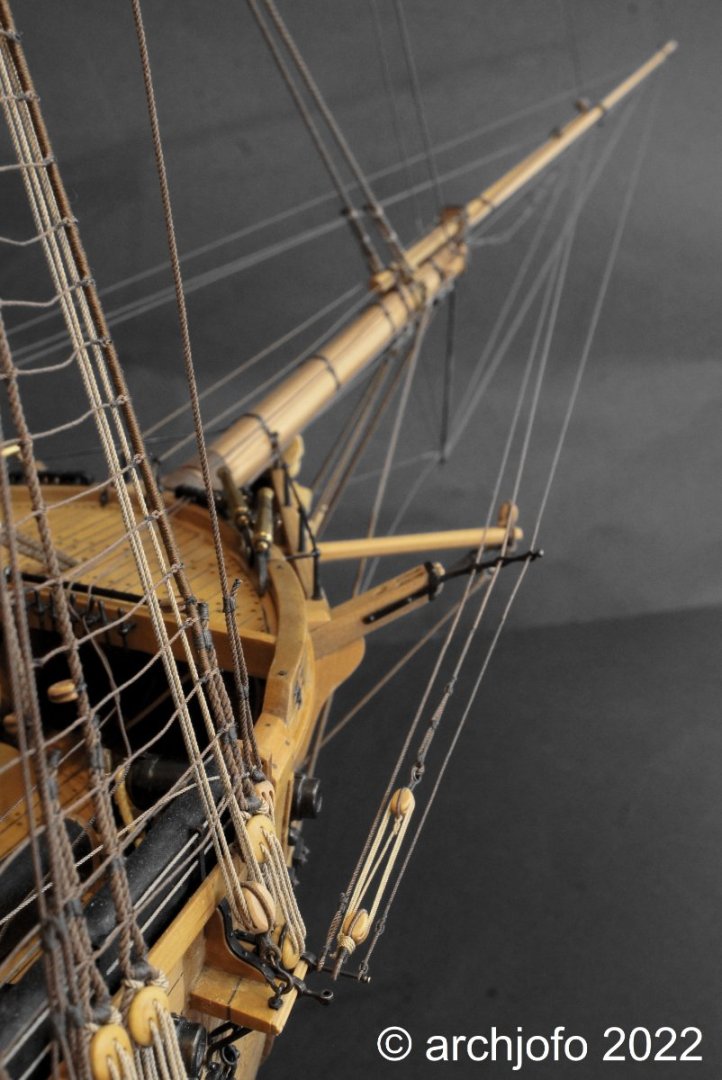
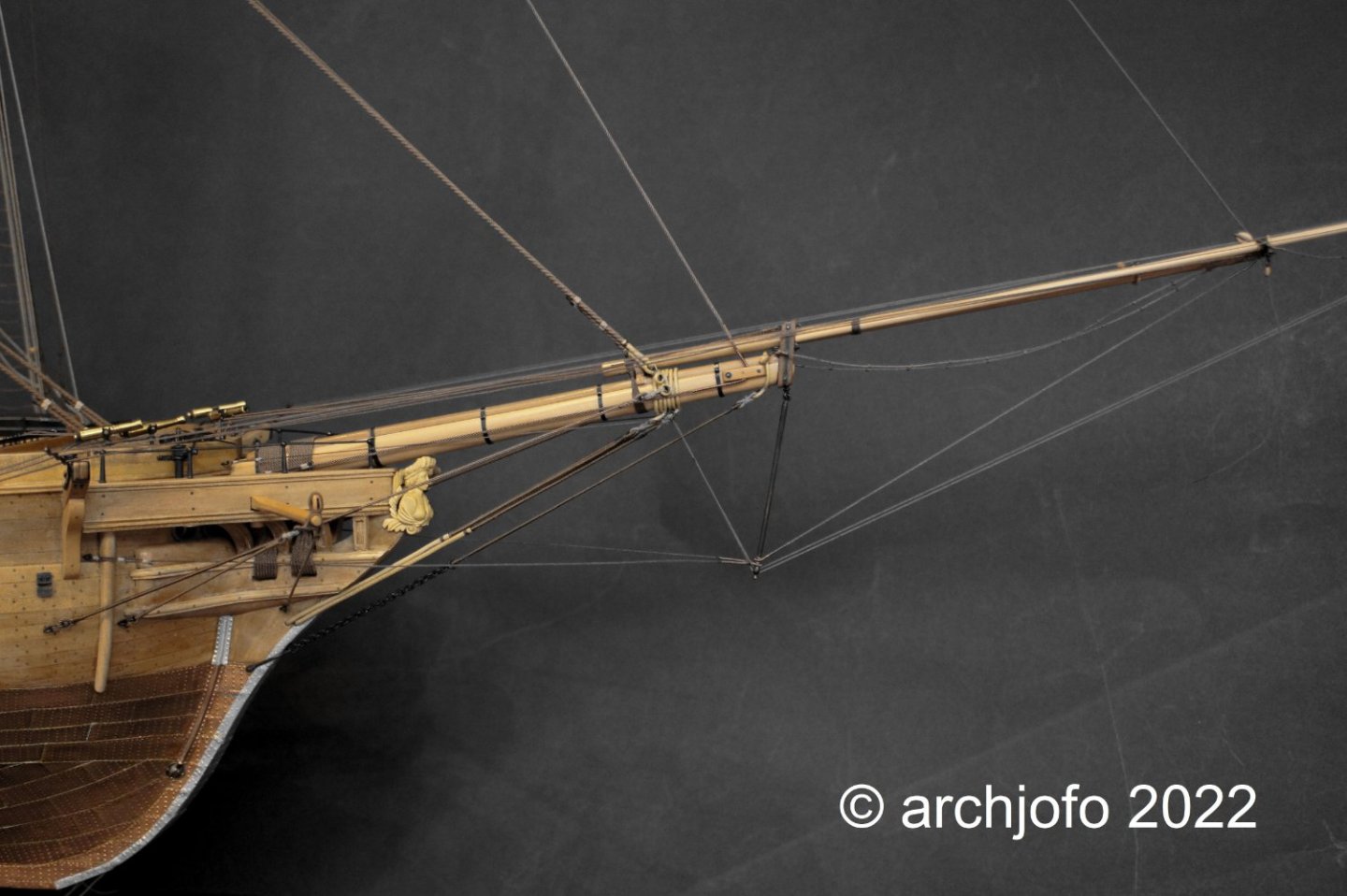
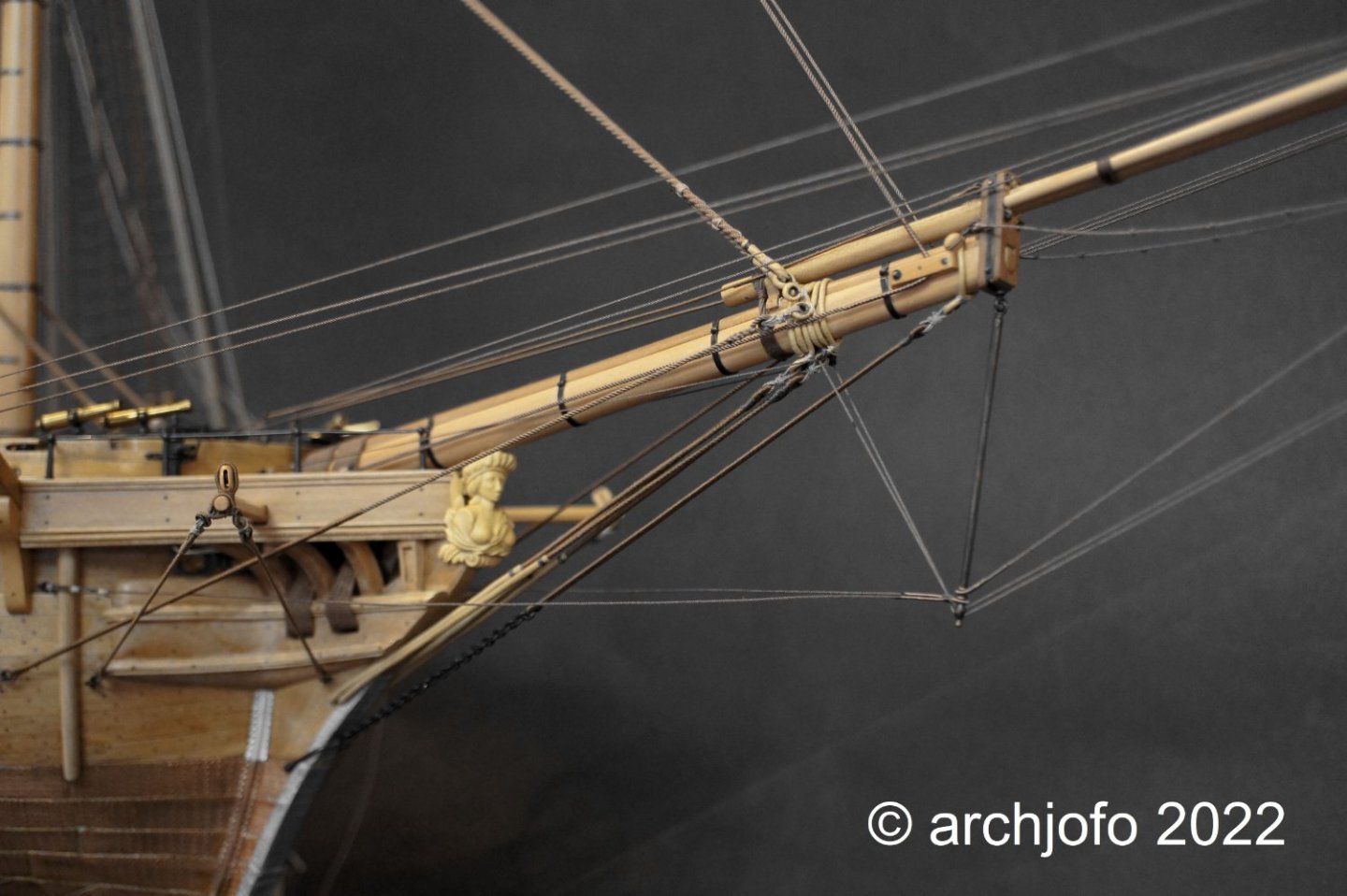

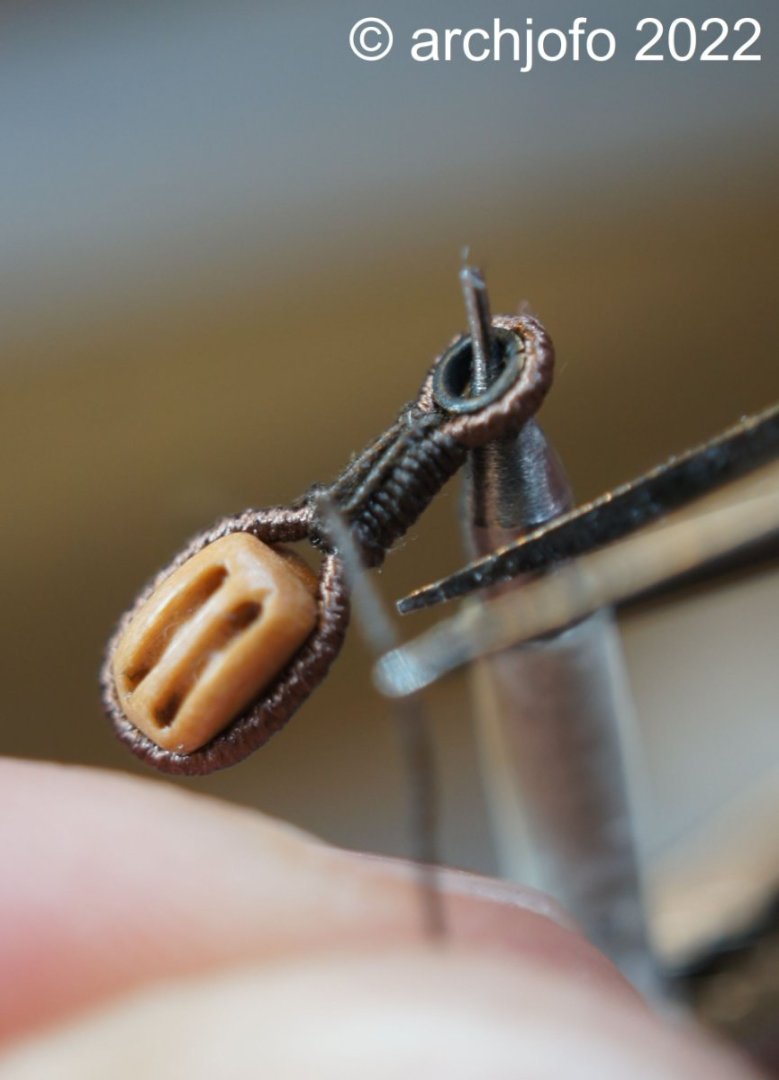
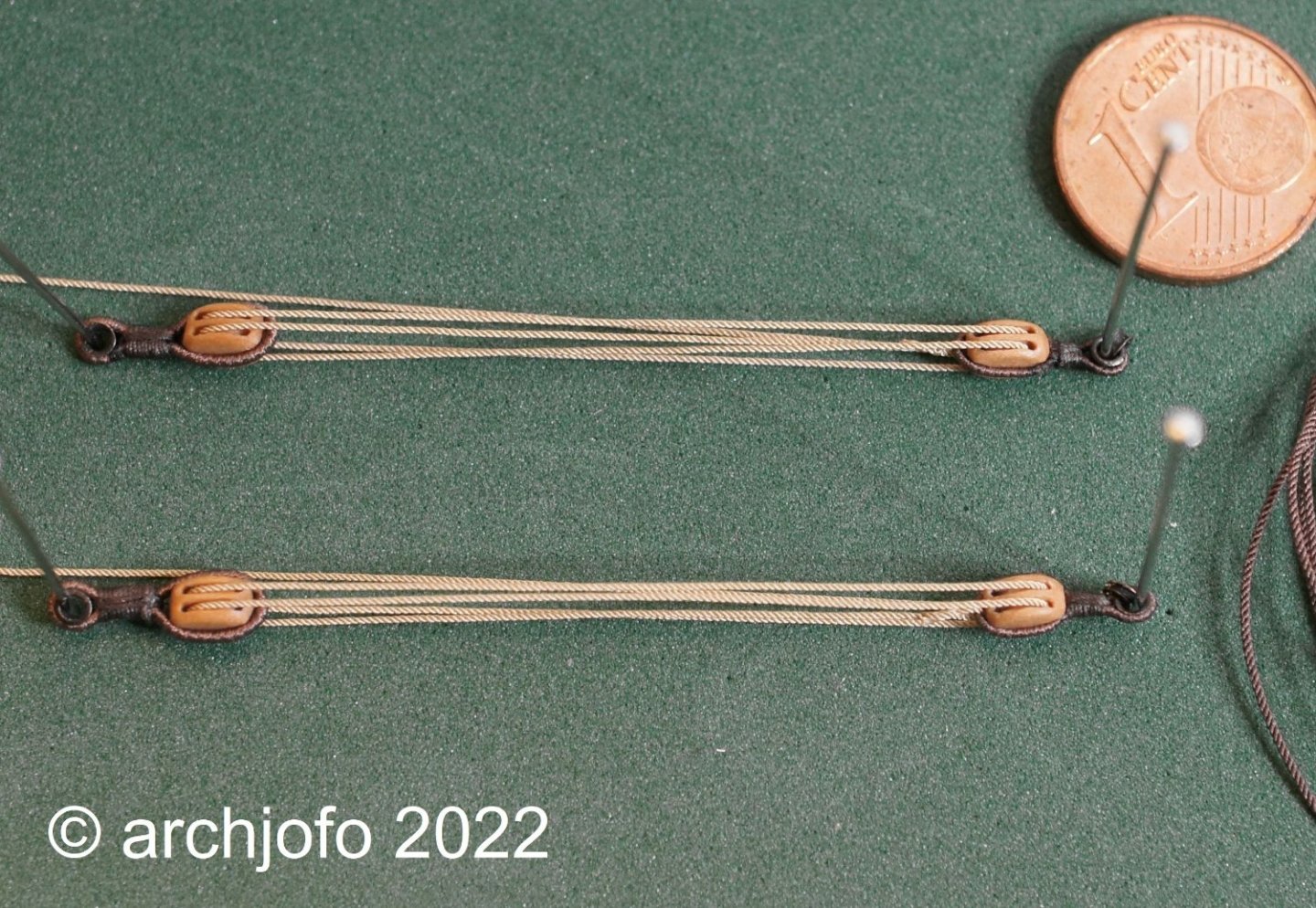
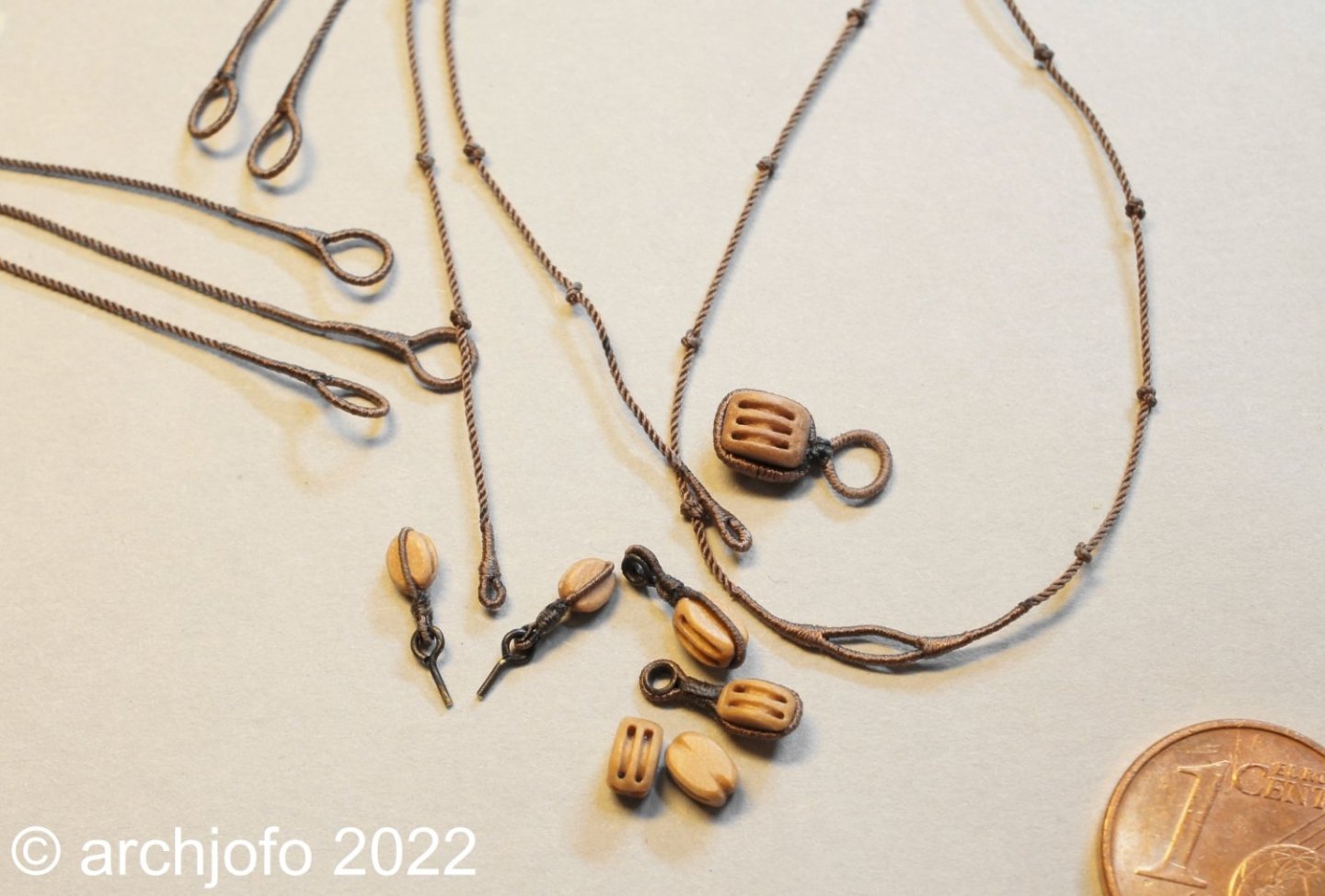
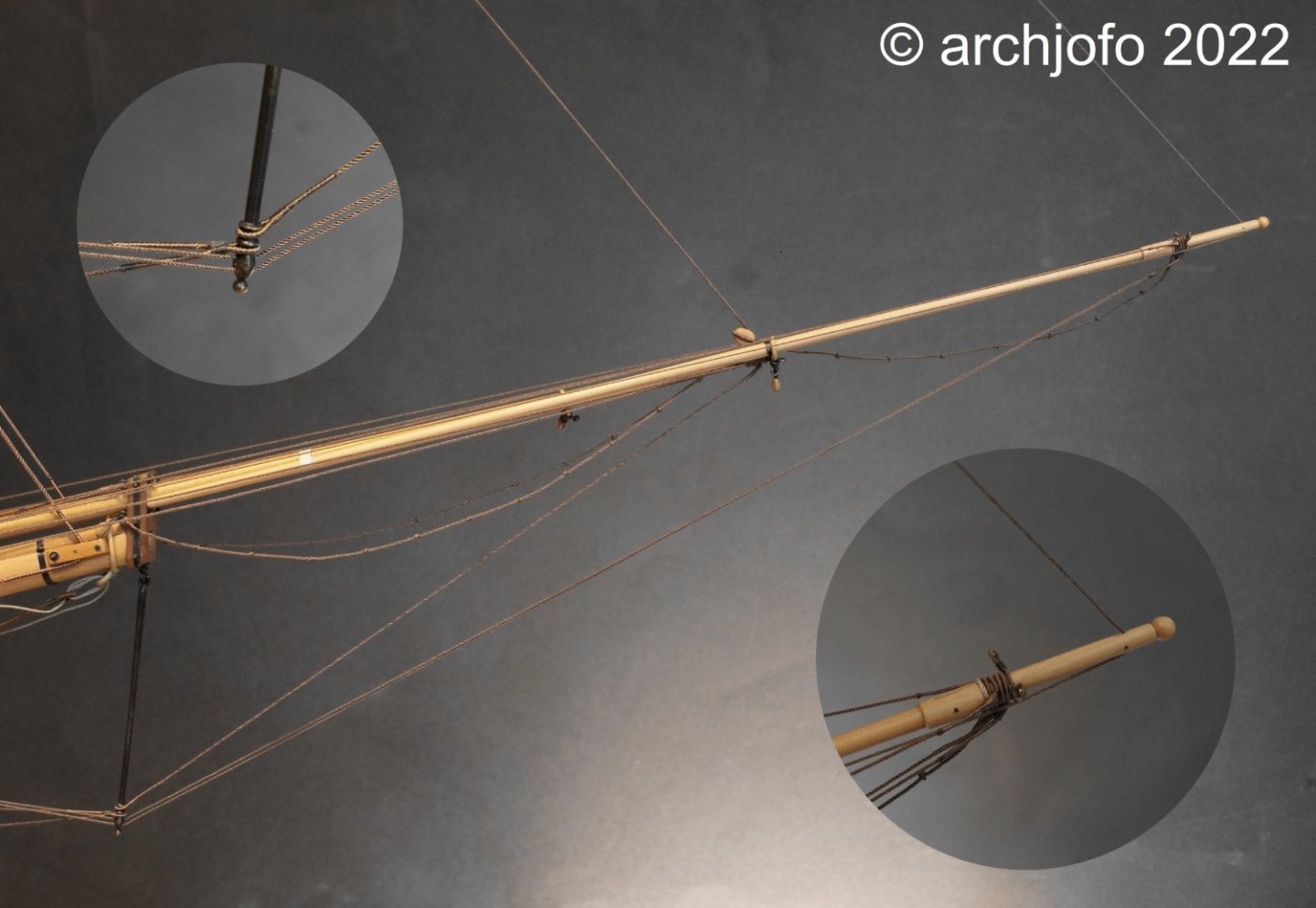
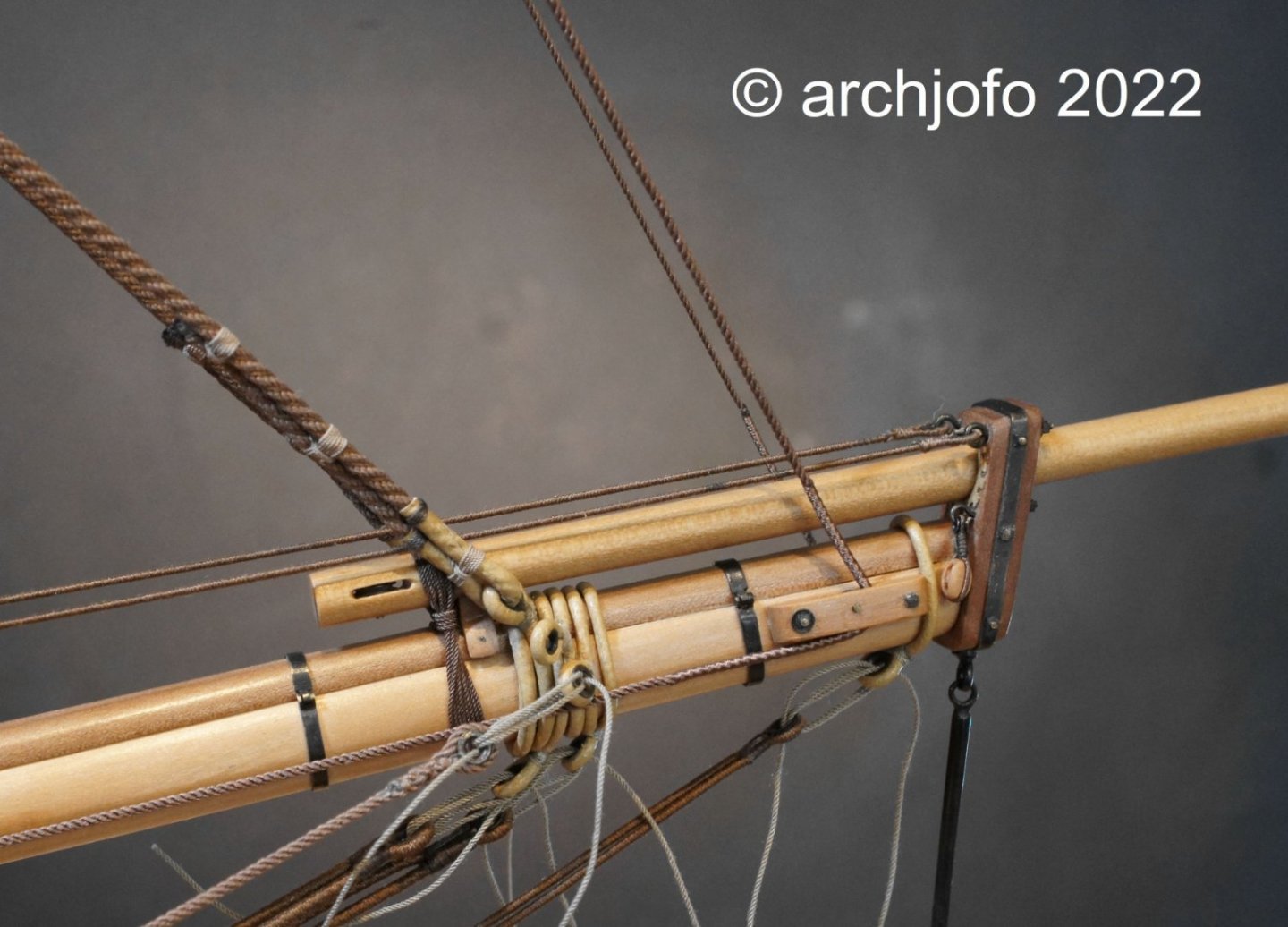
La Créole 1827 by archjofo - Scale 1/48 - French corvette
in - Build logs for subjects built 1801 - 1850
Posted · Edited by archjofo
Hello Gerard,
Thank you very much, that is a very big help, especially the chronological classification.
This gives me confidence in my decision to bring the studding sail boom irons directly in front of the yards.
I recently received higher resolution images from La Créole from the Musée national de Marine Paris. You can see the details of the yardarms a little better there. But only so far that you can see that the studding sail boom irons do not have a 45 ° angle, but place the studding sail boom directly in front of the yards.
Here I show a compilation of the lower yard arms of La Créole in the form of excerpts from the image material available to me.
Source: Musée national de Marine Paris